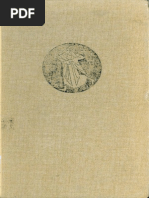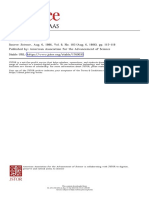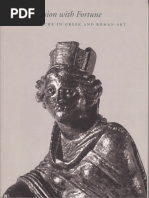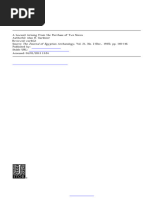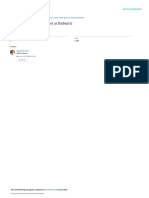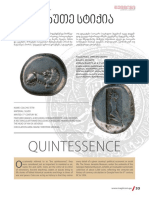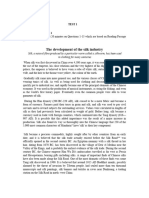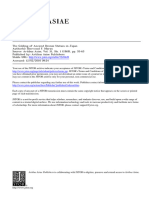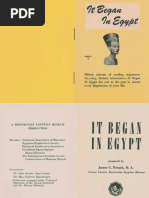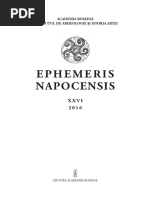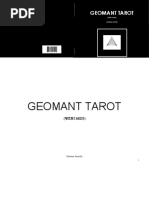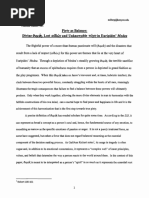Princeton University Art Museum
Princeton University Art Museum
Uploaded by
Frida HorvathCopyright:
Available Formats
Princeton University Art Museum
Princeton University Art Museum
Uploaded by
Frida HorvathOriginal Title
Copyright
Available Formats
Share this document
Did you find this document useful?
Is this content inappropriate?
Copyright:
Available Formats
Princeton University Art Museum
Princeton University Art Museum
Uploaded by
Frida HorvathCopyright:
Available Formats
The Changing Fashions of Roman Silver
Author(s): Andrew Oliver, Jr.
Source: Record of the Art Museum, Princeton University, Vol. 63 (2004), pp. 2-27
Published by: Princeton University Art Museum
Stable URL: http://www.jstor.org/stable/3774841 .
Accessed: 13/05/2014 08:27
Your use of the JSTOR archive indicates your acceptance of the Terms & Conditions of Use, available at .
http://www.jstor.org/page/info/about/policies/terms.jsp
.
JSTOR is a not-for-profit service that helps scholars, researchers, and students discover, use, and build upon a wide range of
content in a trusted digital archive. We use information technology and tools to increase productivity and facilitate new forms
of scholarship. For more information about JSTOR, please contact support@jstor.org.
Princeton University Art Museum is collaborating with JSTOR to digitize, preserve and extend access to
Record of the Art Museum, Princeton University.
http://www.jstor.org
This content downloaded from 193.224.39.62 on Tue, 13 May 2014 08:27:37 AM
All use subject to JSTOR Terms and Conditions
The ChangingFashionsof Roman Silver
ANDREW OLIVER, JR.
In i895, duringthe explorationof an ancientRoman villa ware (cups,bowls,dishes,and the like). In the Boscoreale
about two miles northeastof Pompeii, south of Mount collectionand in ancientpicturesof silver,we can distin-
Vesuvius,in an area known since the time of the Bourbon guishsilverforeatingfromsilverfordrinking. A wall paint-
kingsof Naples as Boscoreale (royalforest),a local land- ing fromPompeii decoratingthe tomb of Caius Vestorius
owner foundnearlyone hundredpieces of Roman silver Priscus shows pairs of silvervesselsused for servingand
tableware.They had been wrapped in a cloth sack and drinkingwine or otherbeverages(argentum potorium): pitch-
stashedin a cistern,surelyforsafekeeping, at the outsetof ers,bowls,cups,and ladlesare symmetrically displayedon a
the eruptionofVesuviusin A.D. 79. Some one thousand table(fig.i).4A fourth-century A.D. mosaicfrom Antiochin
gold coins in a leatherpurse and gold jewelrywere found Turkey, excavatedby an international consortiumin which
beside a skeletonnearby.The original owners had never PrincetonUniversityhad a leading role,shows silverused
returnedto retrievetheirvaluables.VincenzoDe Prisco,the foreating(fig.2).5 An appetizercourseis laid out on a silver
nineteenth-century owner of the propertyon which they charger:eggsin silvereggcupswith silverspoons,and trot-
were found,sold the silveralong with objectsfoundat the tersand artichokesarrangedarounda bowl of sauce. Silver
same site to the Neapolitan antiquities dealer Ercole for eating and drinkingcould be supplementedby silver
Canessa,who in turnarrangedfortheirexportfromItaly. used forbathing,argentum balneare.6
He offeredthe silverand jewelryto the Louvre at a price
thenconsideredto be exorbitant; when the Louvre balked,
Canessastartedsellingpieces individuallyelsewhere. At that
point,theBaron Edmond de Rothschilddonatedfundsfor
the Louvre to buy the silverand thejewelryfoundnearby.
In addition,he retrievedall but one of the items that
Canessa had sold elsewhere.He reservedforhimselfa few
major pieces that,nearlya centurylater,in i990, were
reunitedwiththerestof the silverin the Louvre.'
The Boscorealesilverwas a servicefora well-to-dofamily.
Ministerium is theLatinnameforsucha service,whichcom-
prisedbothsilverforeating(argentum escarium)and silverfor
drinking(argentum These termsare known from
potorium). 44
legalopinionson legaciespreservedin theDigestof Roman
law commissionedby the earlyByzantineemperorJustinian
I (r. 527-565).2 One passage,forexample,reads:"A certain
centurionhad lefthis wife the argentum the silver
escarium,
used foreating.Now, the questionwas: since thishead of
the householdhad vesselsamong his silverfromwhich he
was accustomedbothto eat and drink,werethelattervases,
namely those used for drinking,also included in the
legacy?"3The judge in thecase saidyes,and theladygot the
lot. Today,insteadof differentiatingsilverused for eating
fromthatused fordrinking, we would distinguish flatware
(forks,knives,spoons, and servingutensils)fromhollow fromthetombofCaiusVestorius
Figurei.Wallpainting Priscusat
Pompeii, Roman,
Italy. first
centuryAD. Reproducedin LuciaPirzio
Opposite:DetailofthePrinceton
silvercup, figure3. Birol Stefanelli,Largentodei Romani(Rome, 199 I), 5.
This content downloaded from 193.224.39.62 on Tue, 13 May 2014 08:27:37 AM
All use subject to JSTOR Terms and Conditions
~~~~~~~~I
M
6 . p~~~~~~~~~~~~~~~~~~~~~~~~~~~~~~~~~~~~~~~~~~~~~~~~~~~~~~~~~~~~~~~~~~~
1 whys A l
't~~~~~~~~~~~~~~~~~~~~~~~~~~~~~~~~~~~~~~~~~~~~~~tg~~~~~~~~~~~~~~~~~~~~~~~~~~~~~t
| ~~~~~~~~~~~~~~~~~~~~~~~~~~~~~~~~~~~Ah
! ~~~~~~~~~~~~~~~~~~~~~~~~~~~~~~~~~~~~~0.
- I
--~~~~~~~~~~~~~~~~~~~~~~~~~~~~~~~~~~~~~~~~~~~~~~~~~~~~~~~~~~~~~~~~~~~~~~~~,-'
E~~~~~~~~~~~~~~~~~~~~~~~~~~~~~~~~~~~~~~~~~~~~~~~~~~~~~~
E
_~~~~~~~~~~~~
.
A_~~~~~~~~~~~~~~~~~~~~~~~~~~~~~~~~~~~~~~~~~~~~~~~~~~~~~~~~~~~~~~~~~~~~~~~~~~~~~~~~~~~~~~~~~~~~~
IN*
__1
3W.
This content downloaded from 193.224.39.62 on Tue, 13 May 2014 08:27:37 AM
All use subject to JSTOR Terms and Conditions
Ancientwritersalso speakofpairsof cups.The first-century
A.D. Roman scholarPliny the Elder,in his work Natural
History, did so in referringto cups made in the old daysby
famous Greek craftsmen(NH 33.I55-7). In his Oration
againstVerres(Ver.2.2.47), Cicero refersto pairs of cups,
"skyphorumparia complura,"among the richesstolenby
Verres,theRoman governorof Sicily,fromcitizensof Syra-
cuse,as iftheytypically had come in sets.
The threecups,eachjust underfourand one-halfinches
tall (i i centimeters),were fashionedfrompartsmade sepa-
rately.Thebowl itselfwas made in two pieces:a smooth,rel-
ativelythickinnerliner,of which only the upper part,an
out-turnedmoldingand a line of punchedhatching,is vis-
ible at the rim,and a thinnerouter casinginto which an
elaborate reliefhas been hammered,the upper edge of
which fitssnuglyagainstthe innerlinerjust below thevisi-
ble moldings.Separatelycasthandles,easyto graspwiththe
middle and index fingersand with the thumbon the top
surface, were solderedboth to therimand to thebottomof
the side of the outerreliefcasing,further securingthe two
partsof the bowl. The ringsof the handleshave leaf-like
flangeson the outerface;theirlowercurvedpartsend in an
ivyleafsolderedto the outerrelief.On theiruppersurfaces
s In ~~~~~OWA .Elf
are palmetteswith vines,and rosettes(fig.4). A stemmed
foot,also castseparately, was solderedto the bottomof the
Figure2. Mosaic fromDaphne, nearAntioch-on-the-Orontes, Turkey. outer reliefcasing,its spreadingbase featuringa sinuous
Roman, thirdcenturyA.D. Antakya,HatayArchaeologicalMuseum
(inv.no. 937). Reproduced in Fatih Cimok, ed., AntiochMosaics
vine in relief.One of the handlesof the Princetoncups is
(Istanbul,
I995), 46. missing, and at severalplaces the reliefis tornaway.
The reliefson all threecups show sanctuariesof Diony-
sus,or Bacchus,as he would havebeen calledin theRoman
Now thatwe havebegunto considerRoman use ofsilver world,in landscapesbounded by treesand fullof mysterious
tableware, let us turnour attentionto a specificobject,a sil- imagesand furniture arrangedin theatricalsettings.Com-
ver cup of the earlyRoman imperialperiod recentlyac- panions of Bacchus occupy center stage:Pan and satyrs,
quiredby thePrincetonUniversity ArtMuseum (figs.3-8).7 both young and old, who, despiteapparentanimation,are
The cup is one of threematchingsilvercups,all originally not ambulatoryindividualsbut stationary herms,theirbod-
withtwo handles:one was acquiredin I997 by theMuseum ies terminating in taperingpillarsinsteadof legs.Verymuch
of FineArts,Boston (figs.9, io);8 and about the same time, alive,however,are young boys,some of whom bringfor-
a New York privatecollectoracquired the thirdcup (figs. wardroosters, a goat,and anothersmallanimal.Flankingthe
II, I2).9We know fromthe Boscoreale silverand fromthe hermsare altarslaid forfiresand tablesset with ritualob-
funerary wall paintingin Pompeii thatRoman silvercups jects. Additionalpropsinclude Bacchic stavesand torches,
of thissortwere made and used in pairs,and sometimesin and most strikingly, actors' masks, some lying on the
setsof four,whichmeansthattheremustonce havebeen- ground,othersperchedon columns,most of themrelating
or stillis somewhere-a fourthcup, a total of two pairs. to Bacchus and his companions.Bacchus was the patronof
This content downloaded from 193.224.39.62 on Tue, 13 May 2014 08:27:37 AM
All use subject to JSTOR Terms and Conditions
Figure 3. Silvercup. Roman, firstcenturyA D. h. I I a cm. diam. 13 S cm. PrincetonUniversityArtMuseum, museum purchase,
Fowler McCormick, Class of 1921, Fund (2000-3 56).
This content downloaded from 193.224.39.62 on Tue, 13 May 2014 08:27:37 AM
All use subject to JSTOR Terms and Conditions
Figure4. Uppersurface
ofthe
handleofthePrincetoncup.
k Z~t
the theateras well as the god of wine;in both roles,he pro- griffins back to back,renderedin three-quarter view.Stone
vided a formof escape fromthe realworld. tablesof thisdesign,among themone in the Metropolitan
On one side of the Princetoncup is a hermof Pan,rec- Museum ofArt,New York,have survivedin quantityfrom
ognizablefromhis goat horns,pipes,and pedum,or shep- the ancientworld.'0Two roostersface offin front, although
herd'scrook (fig.3). In frontof him is a fruit-laden table a tearin the reliefhas removedall but the tail feathersof
with a supportin the form of a branch,in the styleof one of them.II The altaron thisside,likewiselaid fora fire,
bronzefurniture of the period.Beside it a smallboy holds is a round one ringedwith decorativezones of rosettes, a
up a rhyton,a vesselin the shapeof an animal'shorn (fig.5). meander,and bulls'skulls(bucrania).
Actors'masksagainflank
Behind Pan a rectangularaltaris festoonedwith a wreath the setting.One on a Doric column has brokenout of the
and laid with kindlingand pinecones.Stuckin the ground relief;two on the groundrepresentPan and a young satyr
behind the altar a torch trailsa ribbon,while above it, (fig.8). Behind the latterappeara treeand a tallcolonnette
thrownovera clothesline, hangsthe skinof an animal,per- topped with a statuetteof Priapus;tied to the column are
haps a badger (fig.6). Two columnsframethissetting,one two Bacchic staffs knownas thyrsoi.
Corinthian,the otherDoric, each topped with an actor's The cups in Boston and NewYork featurerelatedver-
mask,a helmetedwarriorand a wreathedmale (Apollo?), sions of Bacchic sanctuaries.Centered on one side of the
and on the groundbeside the Doric column a thirdmask, Boston cup is the herm of a bearded figure,Priapus,in a
thatof a satyr. contortedpose (fig.9). Nearby,in frontof a cloth sheet
The otherside of the Princetoncup showsa hermof a pinned up to the background,an incense burner stands
youngsatyrswinginghis crook (fig.7). Near him a tableis readyforuse; incense burnersof this designare foundin
set withthreedrinkingcups.This timea stonetableis rep- wall paintingsfromRoman villasburiedby the eruptionof
resented,with supportsin the form of abbreviatedlion- Vesuvius.'2On the otherside of theherman altardisplaysa
This content downloaded from 193.224.39.62 on Tue, 13 May 2014 08:27:37 AM
All use subject to JSTOR Terms and Conditions
.. - . l.
- ~~~~~~~~~~- 4
4' i
columnwithan actor'smask,detailofthe
Figure5. Corinthian Figure6.Doriccolumnwithan actor's
mask,
detailofthePrinceton
cup.
Princeton cup.
A_~~~4
4.:~~~~~~,
4
Figure . Young satyr, detail of the Princeton cup.
Fu A8OA
detailofthePrinceton
Figure7.Youngsatyr, cup. Figure8. Colonettewitha statueofPriapus,
detailofthePrinceton
cup.
This content downloaded from 193.224.39.62 on Tue, 13 May 2014 08:27:37 AM
All use subject to JSTOR Terms and Conditions
Figure9. Silvercup. Roman, first
centuryA.D.; tracesof gold leaf,
h. I I. I cm.,diam.I 0. I cm.Museum
__" of Fine Arts,Boston,WilliamFrancis
Warden Fund, FrankB. Bemis Fund,
___ AVAW~i~w~b',,u,.mg~emaw.~. ~ .~John H. and ErnestinePayne Fund,
and William E. Nickerson Fund
(1997.83).
I LL 5*
}~~~~~~~-i~ ~
- -? .; .......... t;w * F.
basketof cups.In frontof the altar,a boy is dragginga small
goat.Leftand rightare masks,one on a column,two on the
ground.The other side of the cup shows the herm of a
youngsatyr, seen frombehind,swinginghis crook (fig.io).
A wood frametable is set with ritualitems:an incense
burner,a box ofincense,and a cup.A youngboy bringsfor-
ward a roosterto face offagainstone alreadyholdinghis
4;.04
place beforethe table.Again,at the sides,thereare masks, ;6i. ' [ ^ i
~~~~~~~~~~~~~~~~~~~~~-;
:t~~~~~~~~~t'sf
#'~~~~0At' '
AR X,I
i ,
4
k_A.u>V.v
5 t - .
some of themon columns. i i ^- . . ,> . {g .... . i~~~~~~~lt
i sJp...s- is s ,j .~:1rf@
The thirdcup,in a privatecollection(figs.I I-I2), offers f~rfl
t.-e v 3" 1 ^1 < v \ 4< ; r . l \ T
*^ > A *iig
anothervariationon thistheme.On one side is a hermof
.~
an old baldingsatyr, a lamp (?) in his righthand,a wineskin FiguSre io eti o1i fiur 9. ,f , .
slungoverhis shoulder,in frontof which a smallboy raises
his hand as ifacknowledgingitspresence.To the leftof the
herm,underneatha wood frametable set with drinking
cups,a snakeslithers out ofa wickerbasketwitha tipped-up
lid.To the right,an altaris framedby crossedthyrsoi, one of
themhung with cymbals,standardmusicalinstruments for
maenads,the ecstaticcompanionsof Bacchus.At each side
is a taperingconical monumentthatcan be understoodas
This content downloaded from 193.224.39.62 on Tue, 13 May 2014 08:27:37 AM
All use subject to JSTOR Terms and Conditions
Figure i i. Silvercup. Roman, firstcentury
h. to rim i i cm., diam. i i. 5 cm. New
A.D.,
A. York,privatecollection.
fail
W A 4 - 4 W
4e
W.-. 4., X.A
1, v -O.
JP'
t
I. 4 40A
-i 14 -W 'Vw
4,
Figure I 2. Reverse side of figurei i.
....
.......
....
-T
'-vr.4,
A 't. a ip 'k
&
414 9AL
4.k W 4,
k''a "y'W'F.IA
'jP4
A
4. 4 -ft
'.I.. A A WA
Af.
44,
W* s'
*04.
w
U 4f A. O.,
A.V.
t W
4k.
This content downloaded from 193.224.39.62 on Tue, 13 May 2014 08:27:37 AM
All use subject to JSTOR Terms and Conditions
innerlineraremissing-Bacchusis presentas one of thelit-
tlefigures,
wile a wingedcupid trieson a mask(fig.I3).'4 In
one of his odes (2.I9), theAugustanpoet Horace describes
his exhilaratingterroras he imagines himselfon some
remotehill coming upon Bacchus:"Bacchus I saw on dis-
tantcrags-I reallymeanit-teaching songsto hisdisciples,
nymphs, and goat-footedsatyrswithalertpointyears."
BACCHIC SANCTUARIES ON OTHER
SILVER CUPS
Other representations of Bacchic sanctuarieson Roman
silverhelp us to comprehendwhat is particularor com-
monplace,technicallyand artistically, about the images on
the cups in Princeton,Boston,and NewYork.
Figure I3. Silvercup. Roman, firstcenturyA.D., h. 9.5 cm. Beverly Ancientcraftsmen drewon the iconographyof paintings
Hills,privatecollection. and sculpture,the descriptivepassagesin poetry,and their
own imaginedelaborations ofmyths representedthere.Artists
could create "realistic"painterlylandscapes,or theatrical
symbolizingApollo in his role as guardianof streetsand settingswith motifspositionedlike stageprops,or abstract
ways,Apollo AgyieusorAgyias,the Greekwordforstreet.'3 tableaux with minimalindicationof spatial depth.They
Though originallyconceived of as monumentsassociated could enhance the illusion of space by juxtaposing and
withApollo,theyare not necessarilyout of place in a Bac- overlappingfiguresand motifs,or by depictingpeople and
chic sanctuary, whereworshipofApollo was possiblein the furniture in three-quarter views. In theirchoice of design
earlyimperialperiod.They nevertheless seem also to have elements,silversmithscould be expansive so that their
takenon a more genericdecorativefunctionand could be inclusionof Bacchic figures, forexample,mightcontribute
interpreted heremerelyas boundarymarkersof the sanctu- to a narrative;or selective,usingBacchic attributessuch as
ary.The otherside of the cup featuresthe hermof a young musicalinstruments, furniture,and masksas synecdoche.
satyr, an altarwith fruit,a table,likewiseof wood, set with Two principalmetalworktechniques,oftenused in com-
cups and illuminatedby a torchhung withribbons,and,in bination,were availableto help achieve pictorialillusions.
theforeground, a boy witha smallanimal(fig.I2).The usual One could engravewith a pointed tool directlyonto the
masksand treesframeboth settings. At the left,againsta tall silver.In the Roman cups consideredhere,thistechnique
column,we see a quiverand a bow. was usuallylimitedto subsidiarydecoration.The otherand
The sanctuariesshown on all threecups are not yet in more common decorativetechnique,by which the design
use; the hermfiguresare onlyprops,awaitingaction.In the elementscame to be modeled in varyingdegreesof relief,
theatricalsettings,only the smallboys with theirsacrificial involvedhammeringthesilverfromtheback to createwhat
animalsand roostersare alive.Participants in the ceremony is known as repousse'.
The reliefcould be shallowor excep-
have not yetarrived.When theywill,theymaywell put on tionallybold and almostin the round,as was oftenthe case
the masksand assumethe guisesof Bacchus and his com- in the representation of masks.Craftsmenalso could add
panions,satyrsand maenads,and otherpersonalities, unless detailsto the reliefwork by chasing,thatis by punching
it is Bacchus himselfwho attends.On a silvercup in a pri- subsidiaryfeaturesdirectlyonto the face of the silverwith
vate collection in Beverly Hills-the foot, handles,and smalltools.Lastly,throughgilding,emphasiscould be added
IO
This content downloaded from 193.224.39.62 on Tue, 13 May 2014 08:27:37 AM
All use subject to JSTOR Terms and Conditions
to selectedfeatures.Thecraftsman of our cups used all three
techniques.Castingwas limitedto the handlesand feetand
thefloraldesignson them.
Four pairsof cups and threesingletonsare relatedto the
group formedby the Princeton,Boston, and New York
cups. On the cup in Beverly Hills already mentioned
(fig. I3), the densityof the composition,in which open
R. T.
space is leftaroundthe trees,furnishings, and figures(Bac-
chusor a priest,andTyche-Fortuna; whethertheyare"real"
figuresor hermsis debated),and themannerin whichthese
elementsare distributed(some isolated,othersoverlapping
one another,all situatedon a groundline) are features com-
parableto thoseon the threecupsjust described.The sub-
ject is divided into two scenes,frontand back (which is A..
which is probablynot significant); the scenes are separated
by the now missinghandles,whose originalpositionsare
markedby tracesof solder visible between the treesand Figure 14. Silvercup fromBerthouville,France.Roman, firstcentury
columns.The depth of the reliefand the minimaluse of h. includinghandles I5.8 cm. Paris,Bibliotheque nationale de
A.D.,
France,Departementdes Monnales, Medailles et Antiques.Repro-
subsidiaryengravingare also comparableto the techniques duced in ErnestBabelon, Le tresor de Berthouville
d'argenterie presBernay
apparenton thePrincetoncup and itscompanions. (Eure) (Paris,I 9 I 6), plateXII.
Anotherpictorialversionofa sanctuary appearson a pair
of cups in the Bibliothequenationalein Paris,foundwith
othersilverin I 830 in theruinsofa Roman templetreasury Cupids astride animals,seen elsewherein early Roman
in France,nearBerthouville(fig.I4) .I5 Roughlycontempo- imperialsculpture, mosaics,and gem engravings, have been
raneouswith some of the silverfromBoscoreale (mid-first associatedwith Bacchus and are appropriatein this set-
centuryA.D.), theseare more substantial cups,twentyper- ting.'7The compositionis similarin conceptionto thaton
cent taller(not countingthe handles,which are of a differ- the Princeton cup: a centralfigurewith small flanking
ent design) and nearlytwice the weightof the Princeton masksand otherBacchic props.The worksare also techni-
cup.Three masks,largerin size and volume and more fully callyrelated:thedepthofreliefis similar, althoughthePom-
occupying the compositional space, are symmetrically peian cups have more subsidiarylinear detail engraved
arrangedon each side in dominantroles-two maskson the directlyonto the surfaceof the silver.The profilesof the
sides,one in the center-taking the place of a Bacchic cups are also similar,
as are the detailsof themoldingsat the
herm,now shuntedaside.Comparedto the Princetoncup, rim and on the stemmedfeet.Only the handlesdifferin
the motifsotherthan the masksare modeled in verylow design.Given theseartisticand technicalresemblances, the
relief,withsome evenbeing engravedon the background. date withina period of threedecades in the middleof the
On a pair of cups foundin Pompeii in i835, part of a firstcentury,fromthe 40s to the 6os (assignedby one
silverserviceof fifty-four pieces now in theArchaeological scholarto the two Pompeiancups),mightalso applyto the
Museum in Naples,attentionis focusedon winged cupids Princetoncup and itstwo companions.'8Anothercup with
paradingon animals:a goat,a bull,a lion, and anotherbig affinities
to the Pompeian cups is a singlesilvercup,exca-
a leopard(fig.I 5).I6 Nearthemareritualvases,
cat,probably vatedin i966 at Matsesta,nearSochi on theBlack Sea coast,
incenseburners,and pedestalswithwickerbaskets, in one of in Russia;on it,wingedcupidsappearin a landscapeofBac-
which a snakeis visible.In a backgrounddevoid of treesare chic symbols:masks,staves,cymbals,an animalskin,and fur-
masks,more vases,and thyrsoi perched on a rockyledge. niture.'9Althoughthe tomb in which it was found also
I I
This content downloaded from 193.224.39.62 on Tue, 13 May 2014 08:27:37 AM
All use subject to JSTOR Terms and Conditions
w__
it.W
JI_|Eii 4*4
:~~~~~~~~~~~~~~~~~~~~~~. :'_
.:...... _
444
* s,34 4* s
cetr .D., h.jj 2jj c. Stahe jue uBri, ..ienam
* .3779- ic lO . l||
..i.R t.oma, , fi.
__17h I7 I -
cnuyA., h. 2c. Staalih Muee zu Belin Antiknam
lun(msc 3779. 13. Rerdue in Pizi Biol Stfnli L'argento
de*
.i
omai, 178w,fi. 171.|l|
FigureI 5. Silvercup fromPompeii. Roman, firstcenturyA.D., h. to rim
i 1.0 cm. Naples, Museo Archeologico Nazionale (no. 25 3 8). Reproduced
in Pirzio Biroli Stefanelli,LargentodeiRomani,130, fig.94.
yielded coins of the emperorTrajan (r. 98-iI7), the cup all the elementsfoundin the Princeton,Boston,and New
resemblesthe pair with cupidsfromPompeii and probably York cups.The mannerin which the reliefis graduatedin
datesnot laterthanthe mid-first century. depth,some featuresand objects in shallow relief,others
The extremesof amplificationand abbreviationattain- bolder,with the ten masksrenderednearlyin the round,
able in the decorationof such cups can be appreciatedby givesthisversiona more pictoriallook, perhapsclose to a
comparingthe scenes on a pair of cups froma hoard of paintedor sculptedversionof the subject.Withthe excep-
Roman silverfoundin I 868 at Hildesheimin Germanyand tion of the blocks making up the wall, no details are
now in Berlin(fig.i6),2o withthe decorativeelementson a engravedon the background.The cups are extantbecause
singlecup foundin I939 at Stevensweert in theNetherlands the whole collectionwithwhich theywere foundwas lost
and now in Nijmegen (fig.I7).21 The representational
reliefs on the Germanfrontier, perhapsduringthe ambushof the
stretchhorizontally,runningcontinuouslyaroundthe cups. Roman commanderQuinctiliusVarusin A.D. 9. This pro-
On the Hildesheim cups are walls markedwith columns posed circumstance oftheirloss combinedwithcomparison
thatencloseBacchic precincts, withtwo stretches ofwall on to well-datedpotterysuggeststhatthecupsweremade early
each cup.Centeredin theopen spacesbetweenthewallsare in the century.22Differentin artisticstylefromthe cups
hermsofBacchic figuresflankedby treesand symmetrically foundat sitesnearVesuvius,theyprobablystemnot froman
disposedmasks,tenmaskson each cup,perchedon the cor- Italian workshop but from one located in the eastern
ner columnsof thewalls,on stoolsand baskets,and even on Mediterraneanor in northernEurope.
an overturneddrinkingcup. Displays of ritual items are On the Stevensweert in a tableaudevoid
cup,by contrast,
everywhere, and animalskinsand musicalinstruments hang of landscape,masksalternatingwithobjectsalludeto a Bac-
fromthe trees.This versionexhibitsin an expandedformat chic narrativeand the individualsinvolved.First,thereare
I2
This content downloaded from 193.224.39.62 on Tue, 13 May 2014 08:27:37 AM
All use subject to JSTOR Terms and Conditions
a'~ ~ ~~~~~~~~
4i
4*T,
Figure I 7. Silvercup fromStevensweert,
Netherlands.Roman, first FigureI 8. Silvercup.Roman,earlyfirst
century
A.D., h. 7.0 cm., diam.
centuryA.D. Nijmegen, Rijksmuseum G. M. Kam. Reproduced in 8.8 cm.TheToledoMuseumofArt,purchased withfundsfromthe
ErnstKiinzl,"Zum Fries des Silberkantharos
von Stevensweert," LibbeyEndowment, giftofEdwardDrummondLibbey(6i.9).
Jahrbuch desRomisch-Germanischen
Zentralmuseums
Mainz I 8 (I971),
plate I 5.
masks of Bacchus, Pan, and two maenads,togetherwith of the relief,as a solder mark shows. Compared to the
musicalinstruments. Second, thereare masksof Hercules Princetoncup and the pairfromHildesheim,everything in
and his consortOmphale,togetherwithHercules'club and theToledo cup looks a bit windblownand disheveled:one
quiver,silentlyrecallingthe drunkennessof Herculesunder mask has rolled on its side. Despite the low reliefand
the influenceof Bacchus.Here,then,thereis no sanctuary, absenceof line engravingon thebackground,the craftsman
merelyallusionsto what took place in one. The reliefis has successfully createdthe illusionof depthin a landscape
bold, nothingis engravedon the background,and no item limitedto by a treeand singleoutcropof rock by placing
overlapsanother. manyof the objectsin frontof one another.All the masks,
A singlecup in theToledo MuseumofArt,lackinghandles for instance,are in the immediateforeground;everything
and foot,exhibitsa fluent,livelyvariationon the Bacchic else lies beyond.This cup was made in the late Roman
theme in unusuallylow relief (fig. i8).23 Many of the Republic or earlyin theAugustanperiod,thatis,duringthe
items on the Princetoncup are also presenthere: masks, lastdecades of the firstcenturyB.C., in all likelihoodearlier
fiveofthemin thiscase,containersand cupsforwine seton thanthe cups fromHildesheim.
a column and an altar,musical instruments, including a A pair of cups with straphandlesin a privatecollection
lyreand reedpipes,and a treewitha goatskin
tortoise-shell features landscapeswithcompanionsofBacchus and is exe-
slung over a branch.The scene, however,lacks a central cutedwithexceptionalfluency, and novelty
pictorialclarity,
focusof the sorton eitherside of the Princetoncup; here (figs.I9, 20).24 The sceneson the two cups are nearlyiden-
the depictionruns continuouslyaround the cup without tical to one another,not merelyrelatedin content,but in
logical points of hiatusfor the attachmentof handles.In thedetailsoficonography, one of onlytwo instancesofsuch
fact,the craftsman had to place one handledirectlyon part duplication, so faras I know (apartfrombotanicalmotifs),in
I3
This content downloaded from 193.224.39.62 on Tue, 13 May 2014 08:27:37 AM
All use subject to JSTOR Terms and Conditions
i %644444;,_
W=' AAAIIIIN4 Figure ig. Silver cup. Roman, first centuryA.D.,
h. io.o cm., diam. io.o cm. NewYork,
privatecollection.
A 0
'C
SA
49
*-A*
.4
4.4 1k 4
4A. . *4- A
v `W -v ip w. Ot 04
k W
wA, 4, A, t 4*4*
4; 1Pv *-,e- -1, kV 01. -#Vg:
A
A
0 0, A
t 4 tk.
*4%,* JDq# Vik i -OLP
At A --Ovtid
'C' M-WO 4 -W w-it, t.
W -A *.ftw
Ok-i*
v; V 'A. T, AVO*
tv -P
A 4.
W
Figure 20. Reverse side of figureig.
A
V.
k 4
.-W-i "N' 1 & -*.'PA 4. W.fA a a v i
O- 14 A I V., t, % 1 6' 't 'O sr -A J,.& *1 APS VW 4 10 WV A 0 F
ib 4. S A-1 .4 A k
#41 W
W*4
0,10 4P O. A 4
sk
Wl
4 A IL
10A.-v 4*41
k- 4-W iE 0, 4.. 4
4,
4, &
'A w Al
-.5.44 -I -Y.- W
M P 4 O*aft. P. Aw- 't.
r. V-S o A Z *A'#:#.q-* P N4414414.011* It
IL.
w,A.,
V
v
4% A.A. V 4-A V.,44A :6 ie
Uk v
4
.4,.jk. v v
-W 4 or
-II e w O'-#iv,O'.4. -4
41W
1, v-, A
This content downloaded from 193.224.39.62 on Tue, 13 May 2014 08:27:37 AM
All use subject to JSTOR Terms and Conditions
Roman silvercups.The craftsman has soughtto describe the familyof Pan on one cup a stele is engravedon the
pictoriallandscapes,not stagesettings withprops.At theleft background;on the other,a woman holds a basketin her
of one set of pictures,the scene is introducedby a hermof lefthand.At the lower leftof the rockyledge,supporting
theupperbody ofBacchus situatedon a pile of rocksin the the hermsof Mercury,a squarestone,on which the profile
shadeof a tree.Nearbya satyrand a fatold silenhave met, imageof a rightear (auris)is engraved,
maysignify a pun on
and thesatyr-club and fawnskinoverhisshoulder,pitcher the name of the artist.
in hand-is pouringwhatis surelywine into the bowl of a Finally,
a cup carvedout of agateshowsa sanctuarycom-
cat-headeddrinkingcup (rhyton) held by the silen.Beyond, parable to those on the silvercups. This piece was first
largelyconcealed by the silen and renderedin shallower recordedin i638 in the treasuryof St. Denis in France,to
relief,a thirdmale figure,framedby swirlingdrapery, holds whichit probablycame throughmedievalroyalcollections,
In one of thetwo renditions,
alofta thyrsus. hisrightleg and having survivedabove ground from antiquity.Afterthe
footare engravedon thebackground;in the other,theyare FrenchRevolution,the cup came into thepossessionof the
absent.On the otherside of the cups,the scene is similarly Bibliothequenationalein Paris,whereit is today(fig.2I).25
introducedby a hermsituatedon a pile of rocksshadedby The entiresurfaceof the cup is carvedin graduatedrelief,
a tree,thistime a herm of Hermes,or Mercury.This is an some partsbold,othersshallow,withyetanotherversionof
old-fashionedherm,merelythe head of the god on a plain a Bacchic sanctuary.On each side,the focusis a grandtable
shaft,his caduceus leaning upside down againstthe shaft. seen in three-quarterview and piled with ceremonialvases
Nearby,Mercury'sson, Pan, sits on rocks tendinga fire, and a statuette(a maenadon one side,a satyron the other),
while a secondfigure, a femalePan,steadiesa basketon her the whole displayprotectedby a cloth canopy slungfrom
head while holdingthe hand of a youngPaniscus.Beyond trees.Bacchic maskslie on the ground,perchon altars,and
hang fromthe branches.There are animals in the fore-
ground.Since silvercups of this shape are known,26 it is
likelythata scene like thiswas includedin the repertory of
decorationforsilverdrinkingcups.
RANGE OF SUBJECT MATTER
PlinytheEldercommentsin NaturalHistory on thechanging
fashionsof silverware: "The capriciousnessof people's taste
causeschangesin silvervasesin a remarkable manner, no one
kind of workshopheld in high esteemforlong-now we
are lookingforFurniansilver,now Clodian,now Gratian-
forwe clearlytake over what is sold in the shop for our
tables"(NH 33.49). He goes on to mentionvarioustech-
niques thathave come into and gone out of fashion.This
passage is importanteven if we cannot fullyinterpretit,
'AWL&. because Plinyclearlystatesthattherewas indeed a constant
changein tasteforsilverware.Whether thismeansevolution
in artisticstyle,as we would understandit,or perhapsonlya
Figure2I. Agatecup.Roman,first A.D. Paris,
century Bibliotheque
nationalede France,Departement desMonnaies,MedaillesetAntiques change in subjectmatter,we do not know.In any event,
(Bab 368).Reproducedin Hans-Peter AntikeGefasse
Biihler, ausEdel- craftsmen were freeto inventor to choose fromamong a
(Mainz,I973), colorplatei.
steinen varietyof stylesand subjectsalreadyin existence.
I5
This content downloaded from 193.224.39.62 on Tue, 13 May 2014 08:27:37 AM
All use subject to JSTOR Terms and Conditions
J.Paul GettyMuseum,Los Angeles.The Gettycup shows
Odysseus in the Underworld (fig. 22).39 The hero has
slaughteredan animal as reportedin book eleven of the
Odyssey,butseatedand standingroundhimarenot theindi-
WM viduals named in the epic; insteadthere are seven men,
posed, dressed,and gesticulating in conversationas if they
were Hellenistic Greek philosophers,intellectualsmore
closelyconnectedto a Roman imperialconceptionof the
Underworld than a Greek one; their relationship to
Odysseushas not yetbeen fullyexplained.
~~~~ A few unusualcups exhibitallegoricalscenesinvolving
\ \ .~~~~~~~~~~~~~Cv ',.
literaryand even politicalfigures.On a pair of mugsfrom
Boscoreale,skeletonsimpersonating poetsand philosophers,
all identifiedby Greekinscriptions, engagein conversation
at a symposiumundera garlandof roses.Euripides,Sopho-
cles,and Menanderare admiringactors'masks;thephiloso-
phers Zeno the Stoic and Epicurus are respectively
Figure22. Silvercup showingOdysseusin theUnderworld. Roman, abstainingfromfood and takinghorsd'oeuvresfroma table
first century handlesi6.3 cm.,diam.
A.D., h. I2.5 cm,w.including over which the inscriptionreads "Pleasure is the goal."
I I .4 cm. TheJ.PaulGettyMuseum,Villa Collection,Malibu,California
Otherinscriptions observethat"Lifeis a stage"or encourage
(96.AM.57).
thedrinkerto "Enjoy whileyou arealivebecause tomorrow
is uncertain."40A pair of cups fromBerthouvillein France
The Bacchic subjects,renderedin a varietyof artistic showsotherliteraryfigures, among themAratos.4'A single
styles,formedonly one of the possiblechoices availableto cup fromMero&in Egyptshowsa highofficialor kingpass-
craftsmen and theirpatrons.A wide range of subjectswas ingjudgment,42 and a pairof cups fromBoscoreale (longin
floralornamentsuchas olive and plane
available:naturalistic the Rothschildcollectionbut reunitedwith the restof the
treebranchesor grapevines,all ofwhichare foundon cups servicein the Louvre in i990) shows eventsinvolvingthe
fromBoscoreale,Pompeii,and elsewhere;27 scenes of birds emperorsAugustusandTiberius.43
or animals,such as long-leggedbirdsin marshylandscapes
on threepairsof cups fromvarioussites;28 or thewild beasts
attackingdomesticanimalson a pair of cups in the New
INSCRIPTIONS
York artmarketin 2000.29 There are also scenesof mytho-
logical creatures,perhapsallegorical,but withoutspecific In an unobtrusiveplace on a piece of silver,usuallyon the
reference to a narrative involvingcupids,30centaurs,3'
story, undersideofthefoot,one oftenfinds,scratchedor punched
marine horses,32 and tritons and Nereids.33In addition, the weightof the item or the com-
in dotted characters,
thereare scenesof religiousrites34 and of heterosexualand bined weightof a set of items,such as a pair of cups,ex-
homosexuallove.35 pressedin Roman pounds and fractionsthereof.On the
Subjects drawn frommythand literatureinclude the Princeton cup and its two companions,no weightsare
LaborsofHerculesand episodesfromthelifeofBacchus on given,but theyhave been weighed;the Boston cup weighs
two pairs of cups fromPompeii,36a scene from Greek 482.5 grams;theone in NewYork,475.6 grams;and theone
tragedyshowingOrestes,Pylades,and Iphigeneiaon a cup in Princeton,lackingone handle,4I3.7 grams.A Roman
in the BritishMuseum,37and excerptsfromHomer on a pound was the equivalentofabout 325 grams,and thuseach
pair of cups fromHoby in Denmark38and on a cup in the ofthesecupsweighstheequivalentofone and a halfRoman
i6
This content downloaded from 193.224.39.62 on Tue, 13 May 2014 08:27:37 AM
All use subject to JSTOR Terms and Conditions
pounds.A pairwould weigh threepounds,a set of four,six
Roman pounds. This has some significancebecause we
know froma varietyof sourcesthata customermightorder
silverwareby weight.He mighteven supplythe craftsman
withthenecessaryraw silverin theformof eitheringotsor
coinsand,tojudge fromtheknownweightsofancientsilver,
this was oftendone in multiplesor standardfractionsof
poundsofsilver, or roundnumbersofsilvercoins.In thiscase,
foursilvercups,each weighinga Roman pound and a half,
are the equivalentof 500 denarii,the silvercoin of the day.
Incito on th boto of th
Althougha weightinscriptionis lacking,a name is not.
Figr 23. otncp
Scratchedon the undersideof each of the threecups is a
name spelled in full,Sisimis,on theBoston and NewYork
cups (fig.23), and abbreviatedSis on the Princetoncup
(fig.24). What does the name signify?Owner, maker,or
perhapsthe businessthatmarketedthe silver?Sisimisis a
Greekname,not a Latinone,butitis writtenin Latinletters.
Most of thenameson Roman silvercups and silverof other
shapes are Roman two- and three-partnames,although
occasionallysingleRoman names are found.These always
have been interpreted, I thinkcorrectly, as owners'names.
Greeknameslike Sisimisare rare.
So faras I know,only one otherGreek name foundon
> , r _i ^t ,T i
ancientsilvercups can be comparedwith thaton the cups
_
Fir, in Princeton,Boston,and New York.In 1930 anothercol-
4 Insripioonthboto ofthePrincetoncup.
lection of silvertableware,more than one hundredpieces,
was foundwrappedin clothand packedin a bronze-bound
wood chestin the ruinsof a Pompeianhouse,the so-called
House of the Menander,named aftera wall paintingfound
thereshowinga portraitof the Greek comic playwright
Menander.44Twopairsof cups fromthiscollectionhavethe
Greekname Apellesscratchedon theirundersides.45 Schol-
ars agree thatApelles was not the owner of the Pompeian
house wheretheywere found.Washe insteadthe craftsman
who made the cups? Possibly,but not unambiguouslyso,
because the few names that are unquestionablythose of
artists,Sabeinos and Cheirisophos,forexample,are written
prominently withinthepictorialreliefson decorateddrink-
ing cups.The name Sabeinos(CABEINOS) is writtenin Greek
directlyon the reliefworkon a pair of cups fromBoscore-
ale.46 These cups featurestilllifes,or perhapsmore accu-
ratelythe French naturesmortes, on which produce and
slaughteredwild game are laid out in tableaux that have
I7
This content downloaded from 193.224.39.62 on Tue, 13 May 2014 08:27:37 AM
All use subject to JSTOR Terms and Conditions
Figure25. Silvercup from
Boscoreale,near Pompeii,
Italy.Roman, firstcentury
A.D., h. 6.o cm. Paris,Musee
du Louvre(Bj I914). Repro-
duced in FrancoisBaratte,Le
tresor romainede
d'orfevrerie
Boscoreale
(Paris,i986), 60.
been interpreted not merelyas representing gifts(knownin centuryB.C., standsbehind the name scratchedon the un-
the ancientworld as xenia)a guestmightbringto his host dersidesofthePompeiancups.In thatcase,thenameshould
but also as allusionsto the seasons(fig.25).47 The side illus- be considerednot so mucha craftsman's signatureas a label,
tratedhere,representing summer,showsa trussedpig,a tor- not necessarily reliable,added by a dealer.52
toise,a bowl piledwithfruit, vegetables,and a pinecone;also I havefoundno one withthename Sisimisin Italy, or else-
represented is a scabbardwith two sheathedknivesresting where in the Mediterranean. The closest,perhapsa variant
againsta jar on which the name Sabeinosis written.48 spelling,is Sitimos,knownin the earlyRoman period-and
The name Cheirisophos, followedby the word"made,"is therefore appropriateforthe cups-but not,so faras I can
likewisewrittenwithinthe decorationon a pair of cups discover,in Italy;in mainlandGreece,thename appearsonly
withHomeric scenesfroma gravein Denmark,now in the in Sparta.53 The identityof Sisimis,therefore,remainsunre-
NationalMuseum in Copenhagen.Theartist's nameis writ- solved.I would arguenevertheless thatSisimisbearsthesame
ten in Greek letterson one cup,phoneticallytransliterated relationto the Princetoncup thatApellesbearsto the four
into Latin characterson the other: Chirisophosepoi or cupsfromtheHouse oftheMenanderin Pompeii,eitherthe
"Chirisophosmade it" (fig.26).49 No suchphraseoccurson name of the firmthathandledtheirsale or the name of a
the Princetoncup, where the name is written,not neatly craftsman to whom theywereattributed by a dealer.
withinthe relief,but scratchedonto the undersideof the The name Sisimisis also writtenon thepairshowingthe
foot.Could itbe thenameofa dealeror wholesalerofsilver? familyof Pan in the privatecollectioncitedabove (figs.i9,
Beforethe port of Ostia was developedin the mid-first 20). Owing to corrosion,thename is readilyvisibleon only
centuryA.D., copper and tin had been importedthrough one of the cups and reads SISIMISIII. The second pair of
the Gulf of Naples, where Capua in particularhad long strokesof theletterM are not apparentand afterthe finalS
been a centerfor the productionof vases and utensilsof are threeverticalstrokes,but here,with no doubt,is the
bronze.50Silverjoined thistrade,withrawsilverfrommines name Sisimisagain,whichlinksthesetwo cups to the set of
in Spain also enteringItalywithinsightofVesuvius.It was threein Princeton,Boston,and New York.A second group
once proposedthatApelleswas to be identifiedwith a sil- of lettersscratchedon the undersideof the footof thiscup
versmithof the firsthalfof the firstcenturyA.D., in the appearsto readMARCIAT.
nearbyItaliantown of Capua.5' That is no longerconsid-
eredlikely.More recentlyit has been suggestedthatanother
silversmith namedApelles,activein the firsthalfof the first
i8
This content downloaded from 193.224.39.62 on Tue, 13 May 2014 08:27:37 AM
All use subject to JSTOR Terms and Conditions
DATES
How is itpossibleto providea convincing,or atleastplausible, sider also the pair of cups in Copenhagen found in a
date forRoman silverlike the cups in Princeton,Boston, princelybarbariangravein Denmark,mentionedabove in
and New York?An itemfoundat a Vesuviansitemustdate connectionwiththe artist'sname Cheirisophos(fig.26). In
priorto A.D. 79, yet thatdoes not meanjust priorto that thecase oftheDanish cups,two unrelatedlinesofargument
year.Roman familiesinheritedsilverand oftenkeptit for convergeto providean Augustandate.The firstdependson
generations.Recall thatthe Latinphrasesforsilverused for an ancientliterarysource.The name Siliusis scratchedon
eatingand silverused fordrinkingcome frompassagesin the undersideof the cups.It has been plausiblyarguedthat
the Roman legal codes dealing with legacies and inheri- thiswas Gaius Silius,mentionedby the Roman historian
tance.So some,ifnot all,of thesilverfoundaroundVesuvius Tacitusas the commanderof the Roman legionsin south-
is likelyto date frommuch earlierthan A.D. 79. Modern ern Germany(GermaniaSuperior)forseven yearsbegin-
scholarshave argued that the silverfromthese sites was ning in A.D. 14, the year of the death of Augustus.It is
made overthecourseof theone hundredfifty yearspreced- furtherproposedthatthesilvercups mayhavebeen a diplo-
ing the eruptionin 79. Speculating,not alwayspersuasively, maticgiftfromSiliusto a non-Roman rulerin theregion.54
on thebasisof style,theyhave assignedgroupsof decorated The second argumentdependson a comparisonto pottery.
drinkingcups to distinctperiodswithinthistimespan. One of the sceneson one of the two silvercups showsthe
What other typesof evidence exist?We alreadyhave TrojankingPriamkneelingbeforethe GreekheroAchilles
citedthe proposedhistoricalcircumstance surrounding the pleadingforthe returnof his fallenson, Hector.This very
loss in antiquityof the silverin Hildesheim,namelythe image shows up in a fragmentof Italianpotterymade in
ambushof a Roman legionarycommanderin A.D. 9. Con- Arezzo in the time of Augustus.55Some scholars have
Figure26. Silvercup fromHoby,
Denmark. Roman, firstcenturyA.D., h.
I0.9 cm. Copenhagen, Danish National
Museum (inv.9.20). Reproduced in
Pirzio Biroli Stefanelli,L'argentodei
Romani,
I27, fig.90.
I9
This content downloaded from 193.224.39.62 on Tue, 13 May 2014 08:27:37 AM
All use subject to JSTOR Terms and Conditions
. f e
Z. o
'A f i
e~~~~~~~~~~~~~~~~~~~~~~~~~~~~~~ t * FF >, < A e _ ......................................
:_
Q~~~~~~~~~
1 4.a4 .~......_
jvh.
X
i:_f
t0
-_:s
f
tiw:?
. ?; 2? s b t 8 > . . Y -* # @ wB B FV B 4g
s]?
?*
Fi*~~~~~~~~~~~~~~~~o
?.
l:
?l
$> 4. A 4.
FA-4 F i>L | 4 % k~,?
.... 0. P 5k
S
f S--
-r
CSf ,Pj.? S*
fil l A-V 'P11
.nr . .?. * 9 zak - * q > -> l . +~~~~~~~~~~~~~~~~~~~j'
,-?
s
?fr
#
k
.* '*
.
".
k4 4 S , 1 ? S5 ? 2@t w5
ff~~~~~~~~~~~~~~~~~~~~~~~ip
AL
r sfwS'+ '/it 1 f< .s .o 4 ?.
^ ?' 2) lE > fS^ a ? f
t*e ?t M
or bi}W leW6=i.gw 2. X. . X.
J
...............
,ikLebw
,S
?
'?E
hf
ii
i'
*g
h A * v W * 4a........
t..
^v .
* .Wb .^0za.>r
.
? ?
8 w \ , -
* :.df
;x ,*F? 5 t = ts#5@tw**
xv .4 +B
$''* * S fv * ^? 9 :* t * te i\ \ w}
; 4 .t~4
* w
3 N_ '44 4!
1 '"4 5?* . .. : :.
f X $ i * 4 $ > #s | ?tt ? ? . ia;
tg
w
*;***
r W
4 s5
* * * i gX F Ff $f t* s X W h * # _J > 9* * g ; v t# * ?S; *e w ?
i * . f~sB ss *. . * * <Ws ? .^ 2 , .<* B. w . v fs < s: # # j t ,+ 8 t t tffi? .A*: uX . *
1b4-ttW4
- HoJ: R Ud
Fnigur 28r. Sive cup Roma, fis centur % .D
:A 4.?f i ar*t market 5.
Ne ?@fX0bbwor i.W ~
Figure27. Illustrationof silvercup showingtheTrial of Orestes,
fromAnzio, Italy.Roman, firstcenturyA.D. Rome, Palazzo Corsini
(inv.no. 67I). Reproduced in Pirzio Biroli Stefanelli,Largentodei
Romani,6i, fig.40.
arguedthatpotteryreliefsof thissort-this is not the only This bringsus to a statement
about old silverbyPlinythe
one of its kind-were done by making molds fromthe Elderin a passageon notablesilversmithswho workedmore
but a commonsource(ratherthanthe dependenceof
silver, thana hundredyearsearlierthanthe timehe was writing:
ceramic on silver)is more likely.56 The evidence drawn " ... and suddenlythis art so deterioratedthatnow it is
fromthe inscriptionon the Cheirisophoscup, combined valued only in old pieces,and distinctionpertainsonly to
withtheceramiccomparison,presentsa compellingcase for reliefsworn by use even if one cannotquite make out the
a date in theAugustanperiod. composition" (NH 33.15 7). One oftheartistscitedbyPliny
These two convergingbits of evidence providea date was a Greek named Zopyrus,who fashionedtwo cups
only forthe cups in Copenhagen,not forthe styleof the showing the Court of the Areopagus and the Trial of
reliefs,
because scholarshave recognizedthatthe cups recall Orestes, an episode of Greek myth dramatizedin the
Greek worksof the fifthor fourthcenturyB.C. The silver Eumenidesof Aeschylus.Today thereare two known silver
cups receivedas diplomaticgiftsin the mistynorthare in cups showingtheTrialof Orestes(figs.27, 28); there,on the
fact"Old Master"copies.Cheirisophosmaynot havebeen a Areopagusin Athens,the goddessAthenais placinga ballot
Greek workingin the earlyRoman imperialperiod but in an urn,castinga tie-breakingvote,thusgrantinglifeand
rathera craftsman who lived centuriesearlier,whose name freedomto Orestes,and askingthe Furies to cease from
on the cups signifiesonly originalauthorship.In fact,even mankindand become theirbenefactors.
afflicting One Fury
the shape of the cup and the designof the handlespredate stands opposite Athena at the voting table; another sits
theRoman imperialperiod.An undecoratedfourth-century nearby,dejectedat thethoughtoflosingformerpower.One
B.C. silverantecedentwas found in the so-calledTomb of of the two cups,the veryfirstof its kind to be foundin
Philip,fatherofAlexanderthe Great,atVerginain Macedo- modern times,was recoveredduringthe dredgingof the
nia,57and a sequence of Greeksilvercups of thisshapecon- Anzio harborin 176i. It passedinto the collectionof Neri
tinuesin the thirdand second centuriesB.C. Corsini,who at the timewas what mightbe called"com-
20
This content downloaded from 193.224.39.62 on Tue, 13 May 2014 08:27:37 AM
All use subject to JSTOR Terms and Conditions
missionerof operationsat thePortofAnzio,"and it is stillin DRINKING CUPS IN OTHER MATERIALS
the family's privatecollectionin Rome.58 Shortlyafterthe
Two-handleddrinkingcups ofthesedesignsweremade in a
cup'sdiscoveryJohann JoachimWinckelmann(1717-1768),
range of materialsotherthan silver.At the expensiveend
the celebratedhistorianof ancientart,illustrated the piece
were cups in gold,known only fromreferences in ancient
in his Monumenti antichiineditiof I767 witha correctinter-
literature(no cups have survived),and in agate,such as the
pretationof the scene (fig.27) .59 The othercup is currently
one in theBibliothequenationalein Paris(fig.2i). For most
in the New York artmarket(fig.28). A comparisonof the
tables,however,ceramicor glasscups were the rule.Pottery
two cups revealsminor differences: while the attitudesof
cups of theshapesdiscussedherewere eitherplainor deco-
the respectivefiguresare close and theirarrangement rela-
ratedin imitationof the more costlydecoratedsilvercups.
tiveto one anothersimilar, the spacingbetweenthe figures
Examplesoccuramongthewidelymanufactured and export-
variesfromone cup to the other.Furthermore, whereasno
ed potteryknownas terra sigillata6'and alkaline-glazed
ware
indicationof landscapeis presenton the Corsini cup,two
producedat severalsitesin the easternMediterranean.62
trees,separatingthe two groupsof threefigures, are posi-
Two-handledglasscups of these designsfeatureseveral
tioned under the handles on the cup in the art market.
techniques.Most common are undecorated,monochrome
Despite these differences, it is obvious thatboth recallthe
cups; some of these,now in the HermitageMuseum in
same originalcomposition,perhapsthe cupsby Zopyrus,or
St. Petersburg,were foundin tombsnear ancientcitieson
perhaps a sculpturalgroup or paintingon which even
the northcoast of theBlack Sea.63More unusualand elab-
Zopyrus'scelebratedcups depended.Abbreviatedversions
oratelyworkedare cups on which accomplishedglassen-
of the storyappear elsewherein Roman decorativearts,
graverspracticedtheirart.Twotechniquesflourished, one at
includingon cameos and claylamps.60
thebeginningof the firstcenturyA.D., the otherat the end
In any event,the cups in the Corsini collectionand in
of the century.The firstwas cameo glass,in which two or
the New York art marketare not originalsby Zopyrus;
morelayersof differently coloredglassformthebody ofthe
instead they are "Old Master" copies produced in the
vase.The decorationwas achievedby carvingawaytheouter
Roman imperialperiod and once the propertyof well-to-
layeror layersto produce a dark,slightlyrecessedback-
do Romans, one of them perhapsthe owner of a seaside
ground,invariably blue,while leavingfiguresand landscape
villaatAnzio.The cupswould havebeen componentsofsil-
in relief,in the color of the outer layer,nearlyalwaysan
verservices,notvaluablecollectors'pieces.In antiquityonly
opaque white. Out of the fewerthan a dozen complete
the originalsilverpiece commandeda price in the market,
cameo vasesknown,thereare onlytwo cups withhandles,
even if,as Pliny says,it was worn with use. In passing,it
one in theJ.Paul GettyMuseum (fig.29),64 the other(foot
shouldbe noted thatthe cup in the NewYork artmarketis
and one handlerestored) knownsincethe 1970s and recently
the mate to the Odysseycup in theJ.Paul GettyMuseum
in the London art market.65Fragmentsof others,readily
(fig.22): size,style,wear,and decorativedetailsof the han-
identifiable,existin variousmuseums.Here the craftsmen
dles and feetare identical.
musthave been consciouslyimitatingdecoratedsilverware.
The threecupsin Princeton,Boston,and NewYork like-
The second techniqueinvolvedcuttingabstractpatterns
wise are not collectors'prizesbut standarditemsof table-
on colorlessglass,as maybe seen on a cup in theSaintLouis
ware of the firstcenturyA.D. Their subject matteris a
ArtMuseum,on thesurfaceofwhichdiagonalrowsofhol-
Roman adaptationof a HellenisticGreek compositionof
low facetshave been cut for optical and tangibleeffects
morethana centuryearlier. The elaboraterenditionson the
(fig.30).66 The cup in St. Louis is the only survivingtwo-
pair of cups fromHildesheimare perhapsthe closestto the
handled facetedglassknown to me, but facetedglassesof
Hellenisticoriginals.
the tumbler shape, without handles, were common.67
Nearly one hundred complete tumblersare known and
thereare countlessmore fragments, althoughnot one has
21
This content downloaded from 193.224.39.62 on Tue, 13 May 2014 08:27:37 AM
All use subject to JSTOR Terms and Conditions
* A
by~~~P
Figure29. Glass cup in cameo technique.Roman, earlyfirstcentury Figure30. Glasscup.Roman,latefirst centuryA.D., h. I I.2 cm.The
A.D.,h. io.5 cm., w. includinghandles I7.6 cm., diam. io.6 cm. TheJ. Saint Louis Art Museum, giftof Mrs. FrankH. Cook (247:1952).
Paul GettyMuseum,Villa Collection,Malibu, California(84.AF.85).
been foundat aVesuviansite.For thisand otherreasons,the
tumblersmustdate to the lasttwo decades of the firstcen-
turyA.D. and the firstquarterof the second century.Cut
glassesimportedfromEgypt were certainlythe rage by
about the year ioo, when Martial publishedan epigram
entitledCalicesvitrei
(glasscups):
HereyouseetheartoftheNile:whilehewishesto
addmore;
ah,howoftenhastheartist
muined
hiswork.
Ceramictablewarenevercompetedwithsilverware, butonce
facetedglasswaregaineda substantial
marketshare,it seems
to haveovershadoweddecoratedsilvertableware. Silvereven
imitatedglass,reproducingthecutfacetsas punchedhollows,
as maybe seen in a second-century
cup fromBerthouville.68
Despite the competitionof glass tableware,customers Figure 3 I. Silvercup fromStraie,Slovakia.Roman, second century
continuedto commissionsilvercupsin thesecondand third A.D.,h. 8.3 cm. Boinice, DistrictMuseum. Reproduced in Das Haus
lachtvorSilber:Die Prunkplatte vonBizertaunddas romische Tafelgeschirr,
centuries.Acomparisonof one of thesewiththosefoundat
ed. Hans-Hoyer von Prittwitzund Gaffronand Harald Mielsch,Katalog
Pompeii and Boscoreale revealsmuch about the evolution desRheinischen Landesmuseums Bonn,vol. 8 (Cologne, I997), 73, fig.I.
of styleand technique.Considerthe subjectson a second-
22
This content downloaded from 193.224.39.62 on Tue, 13 May 2014 08:27:37 AM
All use subject to JSTOR Terms and Conditions
Figure 32. Frontpanel of a sar-
cophagus with scenes fromthe
childhood of Bacchus, detail.
Marble,h. 38.5 cm.,1. 150.5 cm.
dow, . _
_Princeton UniversityArt
Museum, museum purchase,
S~~x~t as w CORK5 < Ajax aptt I f = ~~~~~~John
Maclean Magie, Class of
1892, and Gertrude Magie Fund
'7
Joj Ax (Y1949-110).
Io
centurysilvercup fromStraze in Slovakia (fig.3I).69 On weight have bought in the Roman marketplace?When
each side appearsa Bacchic sanctuary, a versionof what is complete,with its missinghandle restored,the cup would
foundon the Princetoncup,but with tablesas the center- have weighed approximately 485 grams (the Boston cup
pieces,each piled with ritualvases. In addition,thereare weighs482.5 grams),equivalentto one and a halfRoman
masks,animals,and Bacchic utensils.The senseof landscape pounds or,expressedin termsof Roman silvercoinage of
is greatlydiminished. The spindlytreesat the boundaries the day, I25 denarii. Legionary soldiers were paid 225
and the tablesand animalsare indeed firmlypositionedon denariiper year(Suetonius,Domitian,7.3), SO the silverin a
the ground,but almosteverything else,like the masksand set of fourcups like thesewould be more thanenough to
the Bacchic props,floatsagainsta blind background.Even pay two legionarysoldiersforone year.Uncultivatedland
moresignificant in technique.The cup wall
is thedifference in Italywas availablefor250 denariiper iugerum, a unit of
is thickand single,not double,and the vesselitself,though land equivalent to approximatelytwo-thirdsof an acre
no largerthanthePrincetoncup,weighsnearlythreetimes (Columella, De rerustica 3.3.1I, usingthefigurei,ooo ses-
as much.No longeris therea thinouterrelieffittedovera tertii,a copper alloycoin,fourof which made a denarius).
smoothliner.The reliefis cast or hammeredin one piece In thisperiod,slavescould be purchasedfor200 to 1,000
with the body of the cup,and the reliefwork is relatively denarii; skilled slaves commanded higher prices.70An
shallowcomparedto thatof the earlyimperialcups. amphoraofwine at Pompeiiand Herculaneumrangedfrom
threeto thirteendenarii.7IThe cup,therefore, was of sub-
stantialmonetaryvalue,and mighteven have been consid-
ered at timesas bullion,giventhe factthatthe Latin poet
THE VALUE OF ANCIENT SILVER
Martial(Epigrams 7.86, 8.7I, IO1.5, I0.57, I.05, I2.36) and
Let us now turnto some finalquestionsand speculatefirst otherancientwritersreferto giftsof silverby weight.
on the value of the silver,in intrinsic, and societal
artistic, Artisticworkmanship addedprestige to itsmonetary value,
terms.What,forinstance,mightthe silverin a cup of this buthow was theworkappreciatedartistically? Judgingfrom
23
This content downloaded from 193.224.39.62 on Tue, 13 May 2014 08:27:37 AM
All use subject to JSTOR Terms and Conditions
thecommentsofPlinytheElder,thecup is unlikelyto have
been considereda work of art.If we were to thinkof the
cup as the ancientequivalentof a modernworkof decora-
tiveart,we maysupposethatthe ancientownerconsidered
it beautifulor elegant.
Silverwareof thissort,thenand now,was an attributeof
social standing.Many"middle-class"familiesare thoughtto
haveowned silvertableware.Very wealthyhouseholdsmight
possessslaveswhose expressresponsibility was themaintain-
ing of silver.Certainlythe lack of silverwas a sign of
poverty(Suetonius,Domitian,i).To whatextentwas silvera
statussymbol?A varietyof sources,includingremarksby
Cicero72and the wall paintingfromthe tomb of C.Vesto-
riusPriscus(fig.i), indicatethatsilverwas displayedon side
tablesor cabinets,suggestinga desireto show it off.Most
likely,however,the possessionof silverdid not necessarily
signify artistictaste,onlywealth.
Finally,
how was thesilverused?In a convivium, or dinner
party.Wecan assertthison thebasisof analogyto the more
or lesscompletesilverservices,includingthosefromBosco-
realeand the House of the Menander.KennethPainterhas
recentlyanalyzedthe silverfromthe House of the Menan-
der,concludingthateach diner (up to eight) would have
had two cups and threeplates;and thatothersilveritems
were used to servethe food.73The Princeton,Boston,and
New York cups togetherwith a hypothetical fourthwould
have servedfortwo diners. ~~~~~~~~~~~~~~~i.
. . :?. P
The existenceofthreecups (withperhapsa fourthlurking
elsewhere)decoratedwith relatedsubjectsand bearingthe
_ e -~~~~-
name Sisimissuggeststhattheybelongedto a silverservice
lostor buriedin a period of emergencyor disaster,although
it is impossibleto know where.A naturalinstinctto associ-
ate themwithaVesuviansite,because of theirresemblance Figure 33. Bronze herm of a satyr,
probablyfrom
to cups fromBoscoreale and Pompeii,is offsetnot just by Pompeii. Roman, firstcenturyA.D., h. 69.2 CM.
WoburnAbbey,by kind permissionof His Grace the
discoveryof the silverserviceat Hildesheimbut also by the
Duke of Bedfordand theTrusteesof the Bedford
recoveryabout 1972, froma sandySerbianriverbedabout Estates.
thirtymilessouthof Belgrade,of a sadlyfragmentary silver
serviceofJulio-Claudian appearance,comprisingtwo drink-
ing cups,a ladle,and sets of plates,eggcups,and spoons.74
The cups could have come fromanywherein the Roman
Empire,or evenbeyonditsfrontiers.
Let us returnonce again to the Princeton,Boston,and
New York cups to look at theirimagery,especiallytheir
24
This content downloaded from 193.224.39.62 on Tue, 13 May 2014 08:27:37 AM
All use subject to JSTOR Terms and Conditions
livelyherms.As we have seen,herms-not masksor cupids NOTES
ridinganimalsor cult tablesset with ritualobjects-form i. A. Heronde Villefosse, "Le trksor de Boscoreale," Monuments Piot,vol. s
the focus of our attention.The herm figures,symbolsof (i 899);Fran~oisBaratte, "Artsprecieuxet propagande imp6riale au debut
de l'empireromain:l'exampledes deux coupesde Boscoreale'"Revuedu
fertility and prosperity, are paramount.As representedon
Louvre 41 (I99I): 24-39.
the cups,theyseemlike a fantasy of inanimateobjectscome 2. The DigestofJustinian XXXIII io.8; XXXIV 2.I9.I2; XXXIV 2.32.3.
to life,yet theyare modeled on three-dimensional lifeless Latintexted.TheodoreMommsenwithPaul Krueger, Englishtranslation
ed.AlanWatson, vol.3 (Philadelphia, 198 5), I 41, I 5 I, I 54.
herms,such as the hermof a beardedBacchus represented
3. DigestXXXIV 2.32.3.
on a second-century Roman sarcophagusin the Princeton 4. GiuseppeSpano,"La tombadell'edileC. VestorioPriscoin Pompei,"Atti
University ArtMuseum (fig.32).75There,satyrsand a mae- deltaRealeAccademia d'Italia:Memorie deltaClassedi ScienzeMoralie Storiche,
series7, vol. 3 (I943): 237 if.;Lucia PirzioBiroliStefanelli, L'argentodei
nad are heavingand pullinga half-tonstoneBacchus to set
Romani(Rome,I99I), 5, colorillus.
it upright. 5. Doro Levi,Antioch MosaicPavements (Princeton, I947), I32-36, plates XXIV,
Consider also a bronze herm more than two feettall, CLII-CLIII; FatihCimok,ed.,Antioch Mosaics(Istanbul, I995), 44-47.
6. DigestXXXIV 2.40.
long on displayinWoburnAbbeyin England,and shownin
7. Princeton University ArtMuseum,museumpurchase, FowlerMcCormick,
i985 at the NationalGalleryinWashington on theoccasion Classof 192I, Fund(2000-356).
of the exhibitionThe Treasure Houses of Britain(fig.33).76 8. Museum of Fine Arts,Boston:William FrancisWardenFund, Frank
B. BemisFund,John H. andErnestine A. PayneFund,andWilliamE. Nick-
The storygoes that Caroline,Queen of Naples, had pre-
ersonFund(1997.83); weight482.5 grams.
sentedit to thesixthDuke ofBedford onAprili i, I 8 I 5,on 9. H. to rimii cm.;diam.ofrimII.5 cm.
the occasion of his visitto Pompeii.Whetherthisstoryis io. Inv.no. I3.15.1: Metropolitan MuseumofArt,Greece andRome,introduc-
tionbyJoanR. Mertens(NewYork,i987), III,fig. 8i.
trueor not,thereseemsto be no doubtthatthe object was
iI. On the cock-fighting motif,see PhilippeBruneau,"Le motifdes coqs
indeed excavatedat Pompeii. It representsexpressivelya affrontbs dans l'imagerieantique,"Bulletinde correspondence 88
hellenique
youngsatyr, dressedas ifagainsta chillair,head back laugh- (i965): 90-I2I; see alsoJ.MichaelPadgett, "ObjectsofDesire:GreekVases
fromtheJohnB. ElliottCollection," Record ofthePrinceton Art
University
ing,his eyes,teeth,and hornsgleamingwithsilver.Wasit a
Museum 6i (2002): 43-45 andnn.25,27 forrecentbibliography.
gardenornament,or a stanchionto greetguestsat a con- I2. Thymiaterion in Greek;turibulum in Latin.For incenseburnersin Roman
viviumdesignedto hintat festivities about to takeplace? wall paintings at Oplontis,see Alfonsode Franciscis, "La villaromanadi
Oplontis," in NeueForschungen inPompeji, ed.Bernard AndreaeandHelmut
The Bacchic sanctuarieson the silvercups in Princeton,
Kyrieleis(Recklinghausen, I975), 9-i8, fig.8. FromBoscoreale, Maxwell
Boston, and New York suggesta settingfor unrestrained L. Anderson, "PompeianFrescoesin The Metropolitan MuseumofArt,"
revelry. Filled with wine and offeredto guests,these cups Bulletinof theMetropolitan MuseumofArt,New York45, no. 3 (winter
i987/88): 23, illus.Actual specimens in silver areknownfromtheHellenistic
musthave helped to bringthe mountainrevelrydown the
period;forthewholeclass,seeMichaelPfrommer, Studien zu alexandrinischer
hill to a Roman convivium, where celebrationcould offera undgrossgriechischer ToreutikfruhhellenistischerZeit(Berlin, i987), 25-4I.
briefescapefromthecaresand realityoftheworld.Thehost I3. On ApolloAgyieus andhismonuments, see Elena di FilippoBalestrazzi in
LexiconIconographicum Mythologiae Classicae 2 (Zurichand Munich,i984),
mighthaverecitedtheopeninglinesofthenineteenth poem
327-32. I thankMichaelPadgett forbringing boththeidentification and
of Horace's second book of odes: thereference to myattention.
14. CorneliusVermeule, "A SilverCup of the Augustanor Julio-Claudian
Bacchum in remotis
carminarupibus Period,"Apollo,i982: I45-49, platesi-iv; ElizabethErringtonand Joe
vididocentem-credite
posteri- Cribb,eds.,TheCrossroads ofAsia:Transformation inImageandSymbol in the
ArtofAncient Afghanistan andPakistan, withMaggieClaringbull, exh.cat.,
Nymphasque discentis
etauris Fitzwilliam Museum,Cambridge(Cambridge, I992), 91-94, no. 97, color
capripedumSatyrorumacutas. plateson pagesx-xi (entry byJohnBoardman).
i5. ErnestBabelon,Le tresor d'argenteriedeBerthouville, presBernay (Eure)(Paris,
Horace goes on to sayin his ode thatmilkand honeywould I9I6), 94-97, platesxi-xiii.
flow,and fountainsof wine. i6. PirzioBiroliStefanelli, L'argento deiRomani, I30-3 I, figs. 94-97.
I7. Henner von Hesberg,"Einige Statuenmit bukolischer Bedeutungin
Rom,"Mitteilungen desDeutschen Archdologischen Instituts, Romische Abteilung
86 (I979): 297-3I7.
i8. ErnstKfinzl,
"Eine Silverkanne
mitKentauromachieaus Pompeji,"Jahrbuch
desRomisch-Germanischen
Zentralmuseums
Mainz22 (I975): 75.
25
This content downloaded from 193.224.39.62 on Tue, 13 May 2014 08:27:37 AM
All use subject to JSTOR Terms and Conditions
1g. G.K. Chamba,"TheTomb DatingfromtheSecondCentury from Matsesta" 37. PeterE. CorbettandDonaldE. Strong,"Three RomanSilverCups,'British
I970, no.2: 232-37, fig.I. I I andfig.2.
Arkheologiia
(inRussian),Sovetskaia Museum 23, no.3 (I96I): 68-87.
Quarterly
20. Manfred Silberfund:
BoetzkesandHelgaStein,eds.,DerHildesheimer Original 38. VagnH. Poulsen,"Die Silberbecher von Hoby,"AntikePlastik8 (Berlin,
vomRomerschatz
und Nachbildung zum Burgerstolz(Hildesheim,1997), 1968): 69-74,plates42-65; CarlWernerMuller,"Das Bildprogramm der
46-48, nos. I3 - I4. Additionalphotographsof one cup in Andrew Oliver,Jr., Silberbechervon Hoby,"Jahrbuch Instituts
Archaologischen
des Deutschen
theGods:800Years
Silverfor ofGreek (Toledo,I977),
andRomanSilver 130-31, 109 (I994): 321-52.
no. 83. 39. Firstmentioned in A PassionforAntiquities.Ancient Artfrom theCollection of
2I. vonStevensweert,"Jahrbuch
ErnstKiinzl,"ZumFriesdesSilberkantharos des Barbara andLawrence Fleischman(Malibu,I994), 356,no.295.See alsoEuge-
Zentralmuseums
Romisch-Germanischen Mainz i8 (I971): ii8-23, plates nioLa Rocca,"La discesadi Ulissenegliinferi in unainterpretazione di et!
I5-i8. giulio-claudia," in Ulisse:nlmitode la memoria, exh. cat. (Rome, I996),
22. KatrinRoth-Rubi,"SilberundTerraSigillataimVergleich zur Herkunft 72-95, figs.I-5; Eugenio La Rocca, "Odysseusin der Unterwelt'" in
einigerglattwandiger Gefaisse aus dem Hildesheimer Silberfund," in Der Odysseus,Mythosund Erinnerung, ed. BernardAndreae(Mainz, I999),
Hildesheimer Silberfund,142-50. 269-77, no. 104. Note also the comments of FrancoisBarattein "Sil-
23. Oliver, SilverfortheGodsI, II7-I8, no. 76. bergeschirr,Kulturund Luxusin der romischen Gesellschaft,"i5. Trierer
24. Fig. i9: h. to rim I0.0 cm.,diam.of rim I0.0 cm.; the secondcup (not Winckelmannsprogramm (Mainz,I998): i8.
shown)measures: h. to rimI0.2 cm.,diam.ofrim9.7 cm.;each approxi- 40. Katharine M. D. Dunbabin, "Sic erimusCuncti... theSkeletonin Graeco-
mately340 grams, justoverone Romanpound. Roman Art,"Jahrbuch des Deutschen Archdologischen InstitutsIOI (I986):
25. Hans-Peter AntikeGefasse
Biihler, (Mainz,1973), 45-47, color
aus Edelstein 37-42; Baratte,
224-29, figs. 65-67.
Le tresor,
plate I; Martin Henig, ed., A Handbookof RomanArt (Ithaca, I983), i6i, 4I. Tresorsd'orfevrerieGallo-Romains (Paris,I989), 86-87,no. I9.
fig. I3I. 42. MuseumofFineArts, Boston(24.971): CorneliusVermeule,"Augustan and
26. DerHildesheimer 45, no. I I.
Silberfund, Juho-Claudian Silver,"AntikeKunst6 (I963): 33-40, plateIO; Oliver,Silver
27. Le tresor
FrancoisBaratte, d'orfevrerie (Paris,I986), 53;
de Boscoreale
romaine fortheGods,122-23, no.77.
TheInsulaoftheMenander
KennethS. Painter, vol.4, TheSilver
at Pompei, 43. Baratte,"Artsprecieuxet propagande imperiale," 24-39; Ann L. Kuttner,
(Oxford,2001), 58-60, plates 7-8; Pirzio Birolli Stefanelli,L'argento
Treasure Dynasty andEmpire in theAgeofAugustus: The Case oftheBoscoreale Cups
dei Romani,256, no. 25, figs.92-93. (Berkeley,I995), and thereviewbyAndrew Wallace-Hadrill in the Times
28. NewYork,J.PierpontMorganLibrary: theGods,I44-45,
Oliver,Silverfor LiterarySupplement, OctoberI8, I996, 6-7.
nos.96-97.Istanbulfrom Vize: L. Byvanck-Quarles "Les vases
vanUfford, 44. AmedeoMaiuri,La Casa delMenandro e il suo tesoro di argenteria
(Rome,
en argenta echassiers in Melanges
conservesa Istanbul," Mansel(Ankara, 1933).
1974), 335-43, figs.I13-17. Louvre fromBoscoreale:Baratte,Le tresor, 45. Ibid.,265-79, 310-14, figs.io6, iii; Painter, InsulaoftheMenander, vol.4,
56-57. 53-56,plates1-4.
29. collection:
One is nowin a private I4, 2000, lot89.
NewYork,June
Sotheby's 46. HerondeVillefosse, Le tresordeBoscoreale, 79-83,nos.I5-I6, and207, fig.5o;
30. Pair of cups in the Metropolitan Museum of Art (I994.43.I-2): "Recent Baratte, Le tresor,60,illustration.
Acquisitions.A Selection:1994-I995," TheMetropolitan Museum ofArtBul- 47. Baratte,Le tresor, 60; Pirzio Biroli Stefanelli, L'argento dei Romani,138,
letin53, no. 2 (fallI995): I6-I7; JoanR. Mertensand CarlosA. Pic6n, figs.I03-4.
"AncientArtat theMetropolitan: RecentAcquisitions by theGreekand 48. WalterN. Schumacher, "Zwei Becher aus Boscoreale,"Mitteilungen des
RomanDepartment," Apollo,July1995: 3 I-32, figs.7-8. Pairofcupsfrom Deutschen ArchdologischenInstituts86 (I979): 249-69.
Boscorealein theLouvre:Baratte, Le tre'sor,
6I -62. 49. Poulsen,"Die Silberbecher von Hoby,"69-74, plates42-65; Milller, "Das
3I. Louvre:JonVande Grift, "Tearsand Revel:The AllegoryoftheBerthou- Bildprogramm derSilberbecher vonHoby,"341-45.
88 (I984):
ville Centaur Scyphi,"AmericanJournalofArchaeology 377-88, 50. Winifred Lamb,Ancient GreekandRomanBronzes (London,I929), 241-44,
plates51-53. Naples,Museo ArcheologicoNazionale:ErnstKiinzl,"Le citingsources.
argenterie,"in Pompei79 (Naples,1979), 224, fig.I33, andVan de Grift, 5i. HermanDessau,Inscriptiones LatinaeSelectae (Berlin,I954), no. I947.
"TearsandRevel,"figs.II - 14. 52. Athenaeus, Deipnosophistae, I1.488; ErnstKiinzl, "Quod sinete factumest
32. Warsaw: KazimierzMajewski, Importy Rzymskie w Polsce(Warsaw, I960), i6, hoc magisarchetypum est? (Martialis8, 34)," Archaologisches Korrespon-
platesxxiv-xxxv. denzblatt 8 (1978): 3I4; Painter, InsulaoftheMenander, vol.4, 27-29.
33. Plovdiv:B. Diakovitch, "ThracianTomb in Plovdiv.. ." (in Bulgarian), 53. P.M.Fraser andE. Matthews, eds.,A Lexicon ofGreek Personal Names, vol.3A,
Sbornik za Narodni umotvoreniia, naukai knizhnina (Sofia)22-23 (I906-7): ThePeloponnese, Western Greece, andMagnaGraecia
Sicily, (Oxford, 1997), 397.
29-55,figs.34-39.Naples:PirzioBiroliStefanelli, L'argentodeiRomani, 8, The nameis absentfromHeikkiSolin,Die griechischen Personennamen in
figs.6-7. Rom,einNamenbuch, 2d ed. (Berlinand New York,2003),a publication
34. Two tumblers in NaplesfromPompeii:PirzioBiroliStefanelli, L'argento dei brought to myattention byCharlesMcNelisofGeorgetown University.
Romani, 259, no.36, figs.I62-63. 54. GaiusSilius:Tacitus, AnnalsI, xod; IV,xviii.Silveras diplomatic Taci-
gifts:
35. Heterosexual love(ofthegods):Painter, InsulaoftheMenander, vol.4,56-58, tus,Germania 5. ErnstKunzloffers a conciseargument in hisentryon the
plates5-6. Homosexuallove:JohnR. Clarke,"The WarrenCup and the twosilvercupsin KaiserAugustus unddieverlorene Republik (Mainz,I988),
ContextsforRepresentations of Male-to-MaleLovemaking in Augustan 569-70.
andEarlyJulio-Claudian Art,"ArtBulletin 75 (1993): 275-94 (a cup nowin "AnAncientReplicaofthePriamBowl fromHoby,"
5S. KnudFriisJohansen,
theBritish Museum). ActaArchaeologica "Arretinaund
I (1930): 273ff.; ElisabethEttlinger,
36. Painter,InsulaoftheMenander, vol.4, 53-56, 60-62, plates3-4,9-I0. Silber,"in Gestaltund Geschichte.
augusteisches Karl Schefold
Festschrift
26
This content downloaded from 193.224.39.62 on Tue, 13 May 2014 08:27:37 AM
All use subject to JSTOR Terms and Conditions
(Antike Kunst, Beiheft4) (Bern,I967), I5-20. See alsoMuller,"Das Bild- (Milan,I987), 68-69, no.3I.
64. DonaldB. Hardenet al.,GlassoftheCaesars
programm derSilberbecher vonHoby,"347 andn. 98. London,November25, I997, lot226; Minerva
65. Christie's 9, no.2 (1998): 29,
56. ArturoStenico,"I figlidi Agamennonea Sminthe: Toreuticae ceramica fig.I 2; BonhamsLondon,JulyI 4, 2004, lot I 2.
arretina,"in Artein Europa:Raccolta di studiin onoredi WartArslan(Milan, 66. AndrewOliver,Jr., ofGlassStudies
"EarlyRoman FacetedGlass,"Journal 26
I965), 5-22; GiuseppePucci,"La ceranmica aretina:'Imagerie'e correnti (I984): 45, fig. 17.
artistiche,"in L'artdecoratf
a'Romed lafindela Republique duPrin-
etau debut 67. Ibid., 35-58.
cipat(Collectionde l'Ecole Francaise de Rome 55) (Rome,I98I), II5-17. 68. Babelon,Tresor d'argenterie, I37-38, no.35,platexxx;PirzioBiroliStefanelli,
57. ManolisAndronicos, Vergina:TheRoyalTombs andtheAncient City(Athens, L'argento deiRomani, I 9 I, fig.I 86.
I984), 149, fig.I09. 69. Boinice,District Museum:Anticke Umeniv Ceskoslovenskych Sbirkach(1979),
58. AdolfMichaelis, Das Corsinische Silbergefdss (Leipzig,I859); GermanHafner, 99,no. 407, plate60; ReinhardStupperich, "RomischesSilbergeschirr der
Iudicium klassisches
Orestis, undklassizistisches (I I3 .Winckelmannsprogramm) mittleren bis spatenKaiserzeit in Germanien," in Das Haus lachtvorSilber,
(Berlin, 1958); Heide Froning,"Die ikonographische Traditionder ed. Hans-Hoyer von Prittwitz und Gaffron and HaraldMielsch(Cologne,
kaiserzeitlichen mythologischen Sarkophagreliefs,"Jahrbuch des Deutschen I997), 72-73, fig.I.
Archaologischen Instituts 95 (ig80): 332-34, figs.8a-c; Denis Knoepfler, Les 70. RichardDuncan-Jones, TheEconomy oftheRomanEmpire, 2d ed. (Cam-
imagiers de l'Orestie: milleans d'artantiqueautourd'un mythe grec(Zurich, bridge,1982), 348-50.
I992), 100- 101, figs. 84-86. 71. Ibid., 364-65.
59. Johann JoachimWinckelmann, Monumenti antichi inediti
(Rome,1767), 203, 72. Cicero,Tusculan Disputations I.5.21: "abacos complures ornavitargento
plateI 5 I; whencePirzioBiroliStefanelli, L'argento deiRomani, 6I, fig.40. auroquecaelato."
60. WernerGauer,"EineAthenastatuette desAthenerNationalmuseums: zum 73. Painter, InsulaoftheMenander, vol.4, 25.
'IudicumOrestis',"Archdologischer Anzeiger (I969): 76-88; Knoepfler, Les 74. IvanaPopovic,AntiqueSilverfrom Serbia(Belgrade,I994), I07-8, 255-65,
imagiers de l'Orestie,I 00 - I O I, figs.87 - 8 8. nos.I40-6I.
6I. E.g.,PeterLa Baume,R6mische Kunstgewerbe zwischen Christi Geburt und400 75. J.MichaelPadgett, ed.,RomanSculpture inTheArt Museum, PrincetonUniversity
(Munich, 1983), 121, fig.103. (Princeton, 200I), 148-54, no. 42.
62. Anne Hochuli-Gysel, Kleinasiatischeglasierte Reliejkeramik (5o v. Chr bis50 n. 76. Gervase Jackson-Stops, ed.,TheTreasure HousesofBritain(Washington, D.C.,
Chr)undihreoberitalischen Nachahmungen (ActaBernensia7) (Bern,I977). I985), 299, no.223 (entry byCarlosA. Pic6n).
63. Nina Kunina,Ancient GlassintheHermitage Collection (St.Petersburg, 1997),
258-59,nos.60-62, colorplate34;a glasscup ofthisdesignwaslentto the
MetropolitanMuseum ofArt in 2002 (L. 2002.14).
27
This content downloaded from 193.224.39.62 on Tue, 13 May 2014 08:27:37 AM
All use subject to JSTOR Terms and Conditions
You might also like
- Ebook PDF Classical Mythology 11th Edition by Mark Morford PDFDocument41 pagesEbook PDF Classical Mythology 11th Edition by Mark Morford PDFphilip.pelote17995% (56)
- Walter F. Otto Robert B. Palmer Trans. Dionysus Myth and Cult 1965Document277 pagesWalter F. Otto Robert B. Palmer Trans. Dionysus Myth and Cult 1965Márcio Henrique Vieira Amaro91% (11)
- The-Frogs-Play-Script SIMPLIFIEDDocument4 pagesThe-Frogs-Play-Script SIMPLIFIEDJessica SimmonsNo ratings yet
- Baker, Oliver - Black Jacks and Leather BottellsDocument220 pagesBaker, Oliver - Black Jacks and Leather BottellsJames Aldrich100% (5)
- EuripidesDocument4 pagesEuripidessir_haseeb0% (1)
- (Fortress Volume 17) Nic Fields, Donato Spedaliere, Sarah Sulemsohn Spedaliere-Troy C. 1700-1250 BC-Osprey Publishing (2004)Document68 pages(Fortress Volume 17) Nic Fields, Donato Spedaliere, Sarah Sulemsohn Spedaliere-Troy C. 1700-1250 BC-Osprey Publishing (2004)Jaffer Abbas100% (6)
- Eating-Drinking Roman BritainDocument313 pagesEating-Drinking Roman BritainFrida Horvath100% (1)
- Digital Booklet - EvangelionDocument10 pagesDigital Booklet - EvangelionChristian CamposNo ratings yet
- 1911_Forsdyke-MinoanPotteryCyprusDocument10 pages1911_Forsdyke-MinoanPotteryCyprusmineoli2004No ratings yet
- Clark - Costume Jewelry in Egypt in The XVIII Dynasty - BMMA-NS-8 - 1950Document4 pagesClark - Costume Jewelry in Egypt in The XVIII Dynasty - BMMA-NS-8 - 1950Marina Esteve PérezNo ratings yet
- A Bronze Mirror With The Titles R T-NSW M (T) - N R WT - RDocument3 pagesA Bronze Mirror With The Titles R T-NSW M (T) - N R WT - RCeaser SaidNo ratings yet
- QOD3008_5Document1 pageQOD3008_5jiayili0388No ratings yet
- Mason CoreaNativeArtists 1886Document5 pagesMason CoreaNativeArtists 1886terzian mikeNo ratings yet
- Potters Marks Tepe YahyaDocument17 pagesPotters Marks Tepe Yahyasmitrovic482No ratings yet
- Chester Beatty Description of A Hieratic Papyrus With A Mythological Story, Love Songs and Other Miscellaneous Texts.Document115 pagesChester Beatty Description of A Hieratic Papyrus With A Mythological Story, Love Songs and Other Miscellaneous Texts.Gustavo R. F.No ratings yet
- Jmfa02 1990 18to29Document13 pagesJmfa02 1990 18to29Amal MohamedNo ratings yet
- The Memphite Stela of Merptaḥ and PtaḥmosĕAuthor(s): Kate Bosse-GriffithsSource: The Journal of Egyptian Archaeology, Vol. 41 (Dec., 1955), pp. 56-63Published by: Egypt Exploration SocietyStable URL: http://www.jstor.org/stable/3855238 .Document11 pagesThe Memphite Stela of Merptaḥ and PtaḥmosĕAuthor(s): Kate Bosse-GriffithsSource: The Journal of Egyptian Archaeology, Vol. 41 (Dec., 1955), pp. 56-63Published by: Egypt Exploration SocietyStable URL: http://www.jstor.org/stable/3855238 .Wilton OrionissisnephorusaminRaosirus BenyahaminNo ratings yet
- Tyche at Sparta PDFDocument14 pagesTyche at Sparta PDFninzuNo ratings yet
- gardiner1935 slave grilsDocument12 pagesgardiner1935 slave grilsMay FaroukNo ratings yet
- Benton Ionian Islands BSA 32 1931 1932 213 246 PDFDocument43 pagesBenton Ionian Islands BSA 32 1931 1932 213 246 PDFStella KatsarouNo ratings yet
- Between Realism and Artistic Convention Woollen Mantles in The Iconography of Roman PalmyraDocument19 pagesBetween Realism and Artistic Convention Woollen Mantles in The Iconography of Roman PalmyraAdam EnanNo ratings yet
- Traditional Crafts of Persia 1966 PDFDocument404 pagesTraditional Crafts of Persia 1966 PDFaristoteles_cerberus2409No ratings yet
- Scientific American 1897Document1 pageScientific American 1897alexandrasanduNo ratings yet
- Brooklyn Museum Brooklyn Museum Bulletin: This Content Downloaded From 195.43.22.135 On Sun, 23 Sep 2018 20:01:43 UTCDocument17 pagesBrooklyn Museum Brooklyn Museum Bulletin: This Content Downloaded From 195.43.22.135 On Sun, 23 Sep 2018 20:01:43 UTCNosoNo ratings yet
- Schneider - Did Rome Engage in Pearling in The Red SeaDocument8 pagesSchneider - Did Rome Engage in Pearling in The Red SeaAtef AlshehriNo ratings yet
- Lucio Mariani Cretan Expedition VII. Statue of An Asclepiad From Gortyna, 1897, USADocument8 pagesLucio Mariani Cretan Expedition VII. Statue of An Asclepiad From Gortyna, 1897, USAОлена Володимирівна СемененкоNo ratings yet
- Ink Id2Document12 pagesInk Id2DiegoNo ratings yet
- Istoric Initial M. NeamtDocument4 pagesIstoric Initial M. NeamtFrumoase Amintiri Din GrințieșNo ratings yet
- Dance in Ancient EgyptDocument12 pagesDance in Ancient Egyptkhaledgamelyan100% (1)
- The Great Temple of Bastet at Bubastis: April 2008Document4 pagesThe Great Temple of Bastet at Bubastis: April 2008Manar Abou El FetouhNo ratings yet
- Formal AnalysisDocument5 pagesFormal Analysisariana.villa32No ratings yet
- Late Hellenistic and Early Roman Invention and Innovation Lead Glazed PotteryDocument20 pagesLate Hellenistic and Early Roman Invention and Innovation Lead Glazed PotteryFrida HorvathNo ratings yet
- Mycenaean Mourning CustomDocument11 pagesMycenaean Mourning CustomIcedoNo ratings yet
- The Frog Motive Among The South American IndiansDocument55 pagesThe Frog Motive Among The South American IndiansmaxxtechnoNo ratings yet
- Valdes, The Gazelle Jar' From Tell Qara QûzâqDocument16 pagesValdes, The Gazelle Jar' From Tell Qara QûzâqCarmen Valdés PereiroNo ratings yet
- 9451 9713 1 PBDocument5 pages9451 9713 1 PBTasaduq Ahmad 46No ratings yet
- მეხუთე სტიქიაDocument10 pagesმეხუთე სტიქიაGeorgian National MuseumNo ratings yet
- Historia Podkowy THE HORSESHOEDocument18 pagesHistoria Podkowy THE HORSESHOEgregNo ratings yet
- Goldman - 1943 - Two Terracotta Figurines From TarsusDocument14 pagesGoldman - 1943 - Two Terracotta Figurines From TarsusMalena TrejoNo ratings yet
- Discovery: Famous Temple and Enclosure of SerapisDocument66 pagesDiscovery: Famous Temple and Enclosure of Serapisosis clausNo ratings yet
- Influence of The Middle Kingdom of Egypt in Western Asia, Especially in ByblosDocument6 pagesInfluence of The Middle Kingdom of Egypt in Western Asia, Especially in ByblosScheit SonneNo ratings yet
- 20559832Document4 pages20559832Yian 1No ratings yet
- Wood LiteracyLuxuryEarly 2001Document19 pagesWood LiteracyLuxuryEarly 2001Detlev WannagatNo ratings yet
- Athens - Vogeikoff-Brogan - Late Hellenistic Pottery in AthensDocument41 pagesAthens - Vogeikoff-Brogan - Late Hellenistic Pottery in AthensGeorgianna LaviniaNo ratings yet
- A Pottery Primer-1911 PDFDocument194 pagesA Pottery Primer-1911 PDFA delca-100% (1)
- Philosophical: Reseanch LLNC"Document4 pagesPhilosophical: Reseanch LLNC"Rodrigo Ramon RecaldeNo ratings yet
- Arkell 1955 Hator PDFDocument3 pagesArkell 1955 Hator PDFFrancesca Iannarilli100% (1)
- 41724744Document33 pages41724744Gokhan MermiNo ratings yet
- The Coins of Athens / (Josephine P. Shear)Document66 pagesThe Coins of Athens / (Josephine P. Shear)Digital Library Numis (DLN)No ratings yet
- reading-2023Document43 pagesreading-2023nhudo.forworkNo ratings yet
- Tic Burials From CyrenaicaDocument6 pagesTic Burials From CyrenaicasalemyounisNo ratings yet
- I G A O C O I K ?: Aus: Zeitschrift Für Papyrologie Und Epigraphik 125 (1999) 195-200Document9 pagesI G A O C O I K ?: Aus: Zeitschrift Für Papyrologie Und Epigraphik 125 (1999) 195-200EdinNo ratings yet
- 1853 - The Boot and Shoe Makers AssistantDocument238 pages1853 - The Boot and Shoe Makers AssistantEdNo ratings yet
- Birth of CivilizationDocument10 pagesBirth of CivilizationDipenSomaniNo ratings yet
- Cambridge University Press, The Classical Association Greece & RomeDocument13 pagesCambridge University Press, The Classical Association Greece & RomeShengtanMaoNo ratings yet
- The Gilding of Ancient Bronze Statues in JapanDocument12 pagesThe Gilding of Ancient Bronze Statues in JapanPredrag Judge StanišićNo ratings yet
- Gazelle JarDocument16 pagesGazelle JarsicoraxNo ratings yet
- Sling Stones of Biblical TimesDocument5 pagesSling Stones of Biblical TimesIancu GiorgianaNo ratings yet
- spoon00west معالقDocument92 pagesspoon00west معالقSalma MahmoudNo ratings yet
- Reading - Palcement Test 1Document10 pagesReading - Palcement Test 1nhuhuyenphan22No ratings yet
- Test 1 - ReadingDocument12 pagesTest 1 - ReadingNguyễn Trần Bá ToànNo ratings yet
- It Began in Egypt, Series A (AMORC)Document14 pagesIt Began in Egypt, Series A (AMORC)sauron385100% (3)
- This Content Downloaded From 193.255.211.64 On Tue, 19 Dec 2023 10:29:44 +00:00Document45 pagesThis Content Downloaded From 193.255.211.64 On Tue, 19 Dec 2023 10:29:44 +00:00ahmet mörelNo ratings yet
- CoinCatalogue UQ Antiquities MuseumDocument143 pagesCoinCatalogue UQ Antiquities MuseumPeter Bruner100% (1)
- It Began in Egypt, Series B (AMORC)Document14 pagesIt Began in Egypt, Series B (AMORC)sauron385100% (1)
- Brick Kilns in Sirmium: Jalija Sava Zbornik Matice SrpskeDocument24 pagesBrick Kilns in Sirmium: Jalija Sava Zbornik Matice SrpskeFrida HorvathNo ratings yet
- The Forgotten Legion Raetia PDFDocument32 pagesThe Forgotten Legion Raetia PDFFrida HorvathNo ratings yet
- Drinking Beer Jennings PDFDocument29 pagesDrinking Beer Jennings PDFFrida HorvathNo ratings yet
- Late Hellenistic and Early Roman Invention and Innovation Lead Glazed PotteryDocument20 pagesLate Hellenistic and Early Roman Invention and Innovation Lead Glazed PotteryFrida HorvathNo ratings yet
- Society For The Promotion of Roman StudiesDocument47 pagesSociety For The Promotion of Roman StudiesFrida HorvathNo ratings yet
- The Roman Ceramic Building Material From Partney: Alan Vince and Kate SteaneDocument7 pagesThe Roman Ceramic Building Material From Partney: Alan Vince and Kate SteaneFrida HorvathNo ratings yet
- Post Roman and Sarmatian Pottery Workshops in Banat Ephemeris Napocensis 26 2016 PDFDocument43 pagesPost Roman and Sarmatian Pottery Workshops in Banat Ephemeris Napocensis 26 2016 PDFFrida Horvath100% (1)
- Classics in Drama-IIDocument17 pagesClassics in Drama-IIJimmi KhanNo ratings yet
- The Birth of TragedyDocument60 pagesThe Birth of TragedyWill JensenNo ratings yet
- كيف (151 200)Document50 pagesكيف (151 200)amoni2000iraqiNo ratings yet
- Characterization of Dionysus in The Frogs Drama ComedyDocument2 pagesCharacterization of Dionysus in The Frogs Drama ComedyAdyatma Putra PratamaNo ratings yet
- Who Are The Deities Concealed Behind The Rabbinic ExpressionDocument13 pagesWho Are The Deities Concealed Behind The Rabbinic ExpressionJohn KellyNo ratings yet
- Dance History, Principles of Dance and Philosophy of DanceDocument7 pagesDance History, Principles of Dance and Philosophy of Dancemaangelicaarriola2029No ratings yet
- King Midas Long ShortDocument3 pagesKing Midas Long ShortripihamdaniNo ratings yet
- Mazes & Minotaurs 1e - Misdeeds & Madness PDFDocument20 pagesMazes & Minotaurs 1e - Misdeeds & Madness PDFImiko RariNo ratings yet
- 2IE-B - Group 2Document13 pages2IE-B - Group 2Rexsielyn BarquerosNo ratings yet
- The Mothers Vol-III - Briffault RobertDocument869 pagesThe Mothers Vol-III - Briffault RobertLeonardoLazéra100% (1)
- Shiva and Dionysus Far Away So Close WitDocument5 pagesShiva and Dionysus Far Away So Close WitMaq WerNo ratings yet
- Musicality of Bacchae by EuripidesDocument12 pagesMusicality of Bacchae by EuripidesPetro VourisNo ratings yet
- Mythology & FolkloreDocument8 pagesMythology & FolkloreMark Rednall MiguelNo ratings yet
- Mythology and Folklore DDocument10 pagesMythology and Folklore DNhor Halil QuibelNo ratings yet
- Implicit Explicit SignalsDocument8 pagesImplicit Explicit SignalsVersoza Nel100% (2)
- Mythology: Gods and GoddessesDocument5 pagesMythology: Gods and GoddessesAntonette RamosNo ratings yet
- Dionysos RevengeDocument19 pagesDionysos RevengemariafrankieNo ratings yet
- Skanda Alexander Romance in IndiaDocument44 pagesSkanda Alexander Romance in IndiadrrajeshnairNo ratings yet
- Narrative Text (Madinah SW XI IPA 5)Document4 pagesNarrative Text (Madinah SW XI IPA 5)Madinah SalsabillahNo ratings yet
- Geomant Tarot (With Cards)Document179 pagesGeomant Tarot (With Cards)Martina Smrzzla Smrzlitz100% (6)
- Henry Shephard. To The Origin of The Cult of DionysusDocument34 pagesHenry Shephard. To The Origin of The Cult of DionysusDr. Henry M. ShephardNo ratings yet
- Clay. The Scandal of DionysosDocument16 pagesClay. The Scandal of DionysosAndrea Marcucci100% (1)
- Piety As Balance in Euripides' MedeaDocument16 pagesPiety As Balance in Euripides' Medeaclockworkoasis7206No ratings yet
- Seaford 2002 Bacchae Ritual and TragedyDocument4 pagesSeaford 2002 Bacchae Ritual and TragedyCeciliaNo ratings yet

